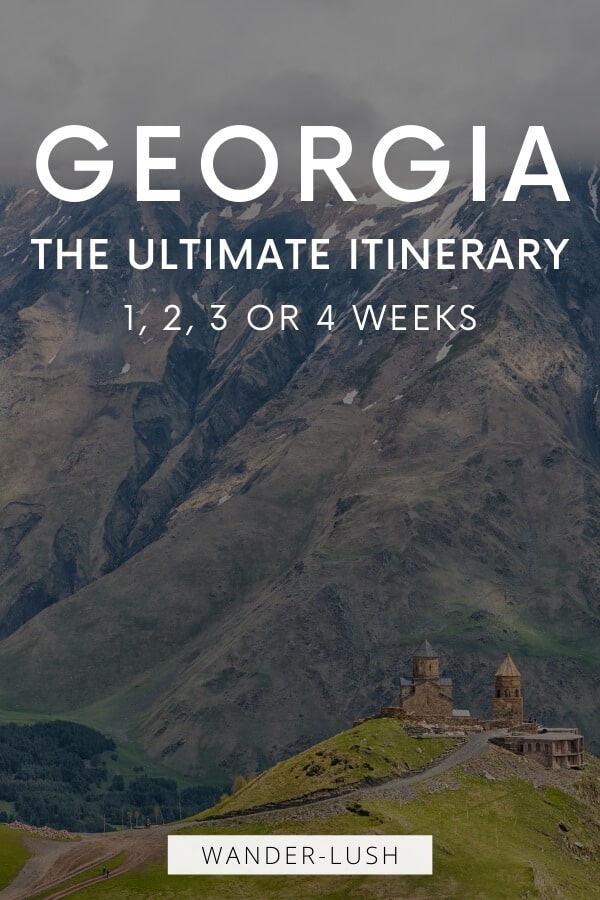The Ultimate Georgia Itinerary: 1-4 Weeks in Georgia the Country
57 min readThe perfect Georgia itinerary for 1-4 weeks of travel in the Caucasus. Includes detailed transportation info, recommended things to do in Georgia, and up-to-date travel advice for 2024.
Oh Georgia. Where do I begin?
Georgia is a place that first captured my heart in 2017 and has been pulling me back ever since. I eventually gave in and moved here at the beginning of 2020.
I have been lucky enough to experience Georgia in every season from the perspective of both a tourist and an expat. Now that I’ve seen almost everything this country has to offer, I finally feel qualified to recommend the perfect Georgia itinerary for first-time visitors, with options for 1, 2, 3 or 4 weeks of travel.
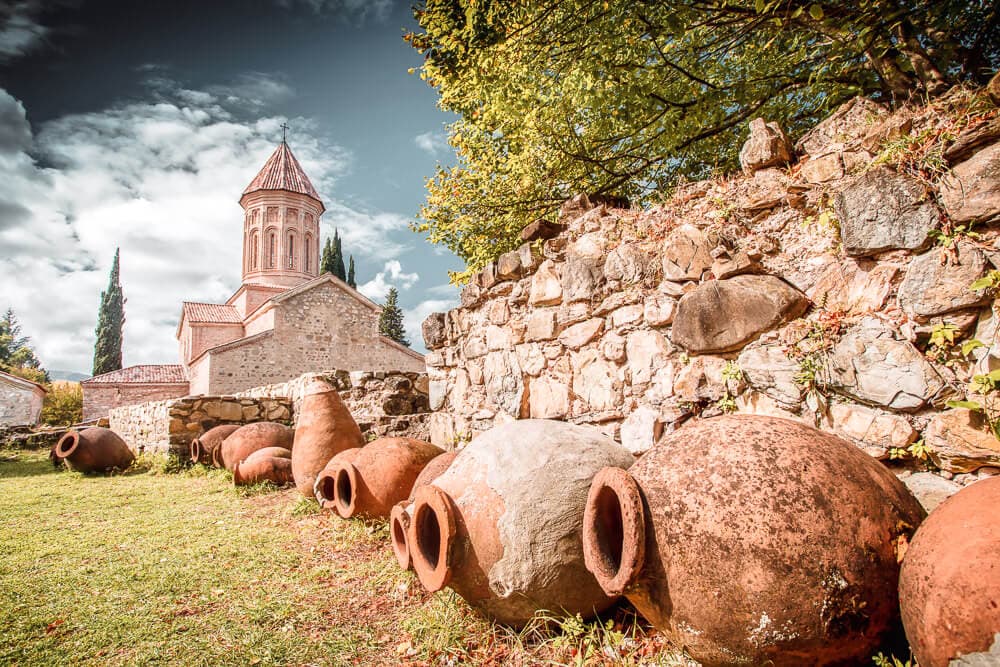
These itineraries aren’t copied out of a guidebook, and they certainly weren’t designed for me by a tour company. Each one is cobbled together from my various travels around Georgia and based on my personal experiences, mistakes and successes. I have personally visited each and every place mentioned here multiple times, and I’ve done everything I can to make sure these itineraries are both realistic and up-to-date.
I have tried to balance the must-sees and not-so-popular spots for a good mix of nature, culture, history and adventure. For each destination, you will find detailed transportation instructions, personal recommendations for where to stay, and my insider tips for making the most of your time.
This guide includes:
5 things to consider when planning a Georgia itinerary
There are a couple of crucial things to consider in the early planning stages that will affect how your Georgia itinerary comes together. To give you a heads up – and to put my own itineraries into context – I’m going to briefly touch on just five.
Remember you can find tons more valuable information about trip planning here in my Georgia Travel Guide.
1. How long should you spend in Georgia?
Many people start planning a short trip to Georgia thinking they can see the whole country in a couple of days. But it’s important to understand that moving around chews up a lot of time.
Anything less than one full week and you’ll just want to base yourself in Tbilisi and stick to day trips (possibly with an overnight stay in Sighnaghi or Kazbegi). It’s possible to see a decent amount of the country in 2-4 weeks – but even then, you’ll be travelling at quite a fast pace and with several long travel days back to back.
The itineraries I’ve created don’t include specialty activities such as multi-day treks. If this is of interest, you’ll have to carve a few days out of your itinerary to fit it in. (I’ve included a couple of key multi-day hikes and where to do them below.)
If you have extra days, I recommend using them to slow down your overall pace and spend a bit longer in each place rather than trying to squeeze more in.
2. When to visit Georgia
There is no ‘bad’ time to visit Georgia – every season offers something different. Spring is nice for mild weather, wildflowers and Orthodox Easter celebrations; fall for the rtveli wine harvest and festivals; summer for hiking and outdoor activities; and winter for experiencing Tbilisi’s cosy side and Christmas festivities plus skiing/snowboarding.
The only time I suggest avoiding is peak summer – July/August – as it’s very warm in the cities and many places (including Tbilisi and Batumi) are overcrowded. My absolute favourite time to visit Georgia is late spring (late April/May) or fall (late September/October). If you want to hike or visit remote mountain regions, avoid the colder months as many roads snow over and are impassable.
My itineraries are specifically designed to be trans-seasonal. The only exceptions are Ushguli and the Goderdzi Pass, which may be inaccessible in the middle of winter.
For more insights, see my month-by-month guide to the seasons in Georgia.
3. Where to start your Georgia itinerary
If you’re flying into Georgia, you have a choice between starting your itinerary in either Tbilisi or Kutaisi. Both cities have international airports with regular connections to Europe, Turkey and the Middle East. Budget travellers usually choose Kutaisi, which is serviced by Wizz Air. Tbilisi, meanwhile, has regular connections from Istanbul, the UAE and Qatar.
I love Kutaisi, but I generally recommend starting your trip in Tbilisi, the capital. The itineraries I’ve designed all start and end in Tbilisi. If you’re flying into Kutaisi, I recommend heading straight to the capital by coach. Georgian Bus runs buses direct from the airport that are timed to leave as planes land. The trip takes around 4 hours and tickets cost 25 GEL. See here for more info.
If flying into Tbilisi, do NOT take a taxi from Tbilisi Airport to your accommodation. Refer to my Airport Guide for information about using the airport bus and organising a reliable transfer.
4. How to get around Georgia
Intercity transport is something you want to consider well in advance as it will impact how long you need to spend in Georgia to see everything you want to see.
That’s because Georgia is small, but transportation is quite basic – it can take a long time to get from place to place if you’re relying on ‘public’ transport. Marshrutka vans are affordable, but schedules are flexible. Road safety is a concern in Georgia, so I strongly suggest you only travel by road during daylight hours and avoid using marshrtuka vans for long journeys or dangerous mountain roads.
Unless you hire a car (recommended for maximum flexibility, but only if you’re a confident driver), you will probably end up using a combination of marshrutka vans and trains, with a few transfers for more complex journeys.
If you do plan on self-driving in Georgia, you can broaden your itinerary even more. Here is my suggested road trip itinerary for 10 days in Georgia, focusing on harder-to-reach corners and hidden gems.
Organised day trips are very affordable in Georgia. They are a good way to make the most of your time, and to get access to alternative areas without self-driving. Even if you’re not a tour person, I suggest you at least consider an organised day trip from Tbilisi.
Friendly.ge is my preferred day tour operator in Tbilisi. Their itineraries are top-notch, as are the expert guides. Browse their private and small group tours here, and use the code wanderlush at checkout to get 10% off when you book direct.
I have sprinkled some specific day trips throughout these itineraries – or you can browse all Georgia day tours using the links below.
Most cities and towns in Georgia have a local bus system that is affordable and easy to use. I highly recommend downloading a taxi app (Grab works in most major cities) rather than hailing taxis on the street – they are unmetered and can be difficult to navigate if you don’t speak the language. See my taxi tips here.
5. Budgeting, insurance, visas & other logistics
Georgia offers visa-free travel for passport holders from 95-plus countries (including Australia, the US and the EU) – and you can stay for up to one year.
Passport holders from most countries in Asia and Africa are required to obtain either an e-visa or a visa in advance. I recommend using iVisa to check if you need a visa for Georgia and to apply for an expedited visa if you do.
You might like to bookmark these helpful guides for future reference:
Recommended pre-trip reading
– How to get from Tbilisi airport to the city
– How to buy and activate a Georgian sim card
– 12 things I wish I knew before I visited the Caucasus
Georgia itineraries for 1-4 weeks of travel
Here is a brief outline of the four itinerary options included in this guide.
Under each section, you will find a day-by-day breakdown including things to do, recommended accommodations, and detailed transportation instructions for travelling from place to place.
One week in Georgia
• Days 1 & 2: Tbilisi
• Day 3: Day trip to Mtskheta, Gori & Uplistsikhe
• Days 4 & 5: Sighnaghi & Kakheti wine region
• Days 6 & 7: Georgian Military Highway & Kazbegi
Two weeks in Georgia
• Days 1 & 2: Tbilisi
• Day 3: Day trip to David Gareja
• Day 4: Mtskheta, Gori & Uplistsikhe
• Days 5 & 6: Kutaisi, Chiatura & Tskaltubo
• Days 7, 8 & 9: Mestia & Ushguli
• Day 10: Zugdidi
• Days 11 & 12: Sighnaghi & Kakheti wine region
• Days 13 & 14: Georgian Military Highway & Kazbegi
Three weeks in Georgia
• Days 1, 2 & 3: Tbilisi
• Day 4: Day trip to David Gareja & Udabno
• Day 5: Mtskheta, Gori & Uplistsikhe
• Days 6 & 7: Kutaisi, Chiatura & Tskaltubo
• Days 8, 9 & 10: Mestia & Ushguli
• Day 11: Zugdidi
• Days 12 & 13: Batumi
• Days 14 & 15: Khulo & Upper Adjara
• Day 16: Akhaltsikhe & Vardzia
• Day 17: Borjomi
• Days 18 & 19: Sighnaghi & Kakheti wine region
• Days 20 & 21: Georgian Military Highway & Kazbegi
One month in Georgia
• Days 1, 2 & 3: Tbilisi
• Day 4: Day trip to David Gareja & Udabno
• Day 5: Mtskheta, Gori & Uplistsikhe
• Days 6 & 7: Kutaisi, Chiatura & Tskaltubo
• Day 8: Martvili
• Days 9, 10 & 11: Mestia & Ushguli
• Day 12: Zugdidi
• Days 13 & 14: Guria
• Days 15, 16 & 17: Batumi & the Black Sea Coast
• Days 18 & 19: Khulo & Upper Adjara
• Day 20: Akhaltsikhe & Vardzia
• Day 21: Borjomi
• Day 22: Tsalka & Javakheti
• Days 23 & 24: Sighnaghi & Kakheti wine region
• Day 25: Telavi
• Days 26 & 27: Pankisi Valley
• Days 28, 29 & 30: Georgian Military Highway & Kazbegi
Georgia itinerary map
Click here to open an interactive map of my Georgia itinerary in a new tab. Each of the four different options is included as a separate layer.
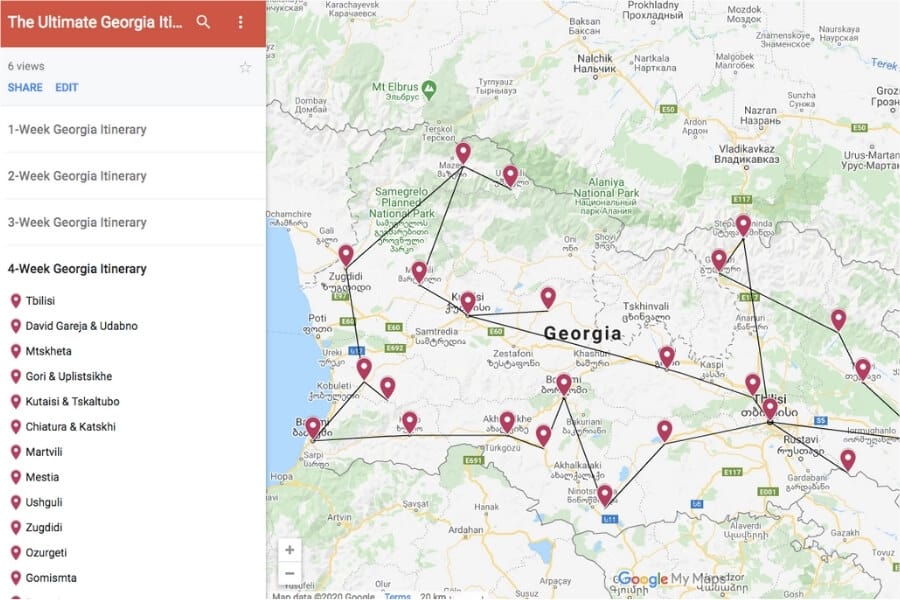
One week in Georgia itinerary
This itinerary for one week in Georgia offers a good introduction to the country. It’s perfect for first-time visitors who want to see the highlights and get a good feel for Georgian culture, food and wine.
If you only have 7 days in Georgia, don’t worry about trying to squeeze too much in – you will almost certainly be back!
Tbilisi – [Mtskheta, Gori & Uplistsikhe] – Sighnaghi & Kakheti –Kazbegi – Tbilisi
- Days 1 & 2: Tbilisi – overnight in Tbilisi
- Day 3: Day trip to Mtskheta, Gori & Uplistsikhe – overnight in Tbilisi
- Days 4 & 5: Sighnaghi & Kakheti wine region – overnight in Sighnaghi
- Days 6 & 7: Georgian Military Highway & Kazbegi – overnight in Kazbegi
Days 1 & 2: Tbilisi
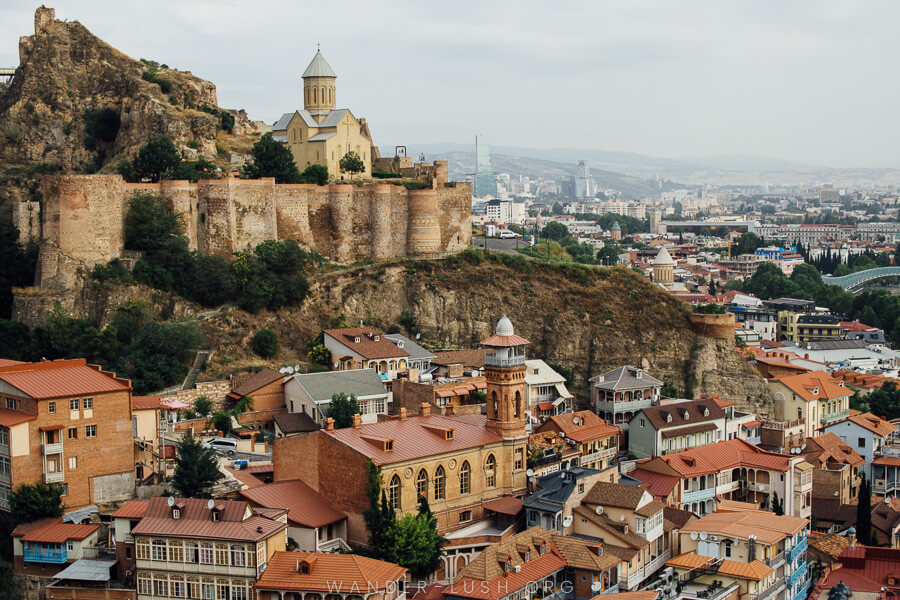
Tbilisi – the coolest city in the Caucasus and one of Europe’s most talked about up-and-comers – is the logical place to begin your Georgia itinerary. This is where you’ll find some of the country’s best museums, restaurants and wine bars.
It might be the capital, but Tbilisi has an intimate feel – especially around Sololaki, the oldest neighbourhood, and in the historic Old Town proper. Tbilisi is a layer cake of different histories and influences collected over a lifetime spent sitting at the nexus of East and West, Asia and Europe.
Ottoman-Persian style bathhouses fed by sulfur springs and an urban waterfall, opulent mansion homes built by Armenian merchants and beautiful Orthodox churches sit side by side with Zoroastrian fire temples, grand synagogues and leftovers from Georgia’s Soviet period.
The cherry on top – the thing that gives the Tbilisi of today its unmistakable character – is a slew of quirky additions to the city’s skyline in the form of ultra-modern architecture.
Scaling the walls at Narikala Fortress, watching the sunset at Mtatsminda, and rummaging the Dry Bridge Market for the perfect souvenir are all must-dos.
Spend some time in the trendy Vera neighbourhood visiting coffee shops and cocktail bars, and pop over the river to Chugureti, the old German district, for unique architecture and the Fabrika creative space.
Two full days is the perfect amount of time to revel in the contrasts between old and new Tbilisi. For a full list of things to do in Tbilisi – including alternative attractions and local favourites – refer to my Tbilisi city guide.
Recommended reading:

If you’re not a huge fan of cities and two full days in Tbilisi feels like too much, you might choose to do a day trip on day 2, or dedicate another day to Kakheti or Kazbegi later in your itinerary.
Where to stay in Tbilisi
There is no shortage of accommodation options to choose from in Tbilisi, ranging from boutique hotels to budget-friendly hostels. My Tbilisi neighbourhood guide explores the different districts and accommodation options in details. Here are a few of my favourites.
Budget hostel: Fabrika Hostel & Suites is Tbilisi’s most popular hostel and hangout. The space, a converted Soviet sewing factory, houses a cafe/bar/co-working area, boutiques and restaurants, and hosts regular events. Accommodation options include hotel dorms and private doubles.
Click here to check rates & availability on Booking.com or read my full review of Fabrika.
Mid-range hotel: For boutique on a budget, I highly recommend Hotel Manufactura in Avlabari. The property is located on a newly refurbished street and is walking distance from both the Avlabari Metro Station and the Abanotubani Sulfur Baths (via Metekhi Bridge). The breakfast here is top notch, and the rooms are very comfortable.
Click here to check rates & availability on Booking.com.
Boutique hotel: The House Hotel Old Tbilisi offers guests the chance to wake up to a typical Tbilisi courtyard, as viewed from a painted wooden balcony. Rooms feature bespoke wall paintings and vintage carpets. Service is professional and warm, and the complimentary breakfast courtesy of Blue Fox’s Michelin-starred chef is the perfect way to start your day.
I have partnered with The House to offer my readers 10% off – use the code WANDERLUSH when you book directly through the website.
Design hotel: Set in a historic 19th-century mansion house that once belonged to an Armenian merchant, Unfound Door embodies the sophistication and edgy elegance of Old Tbilisi. The painted stairwell will blow you away. Unfound Door Restaurant is one of the finest in the city for both breakfast and lunch/dinner – and cocktails.
Day 3: Day trip to Mtskheta, Gori & Uplistsikhe
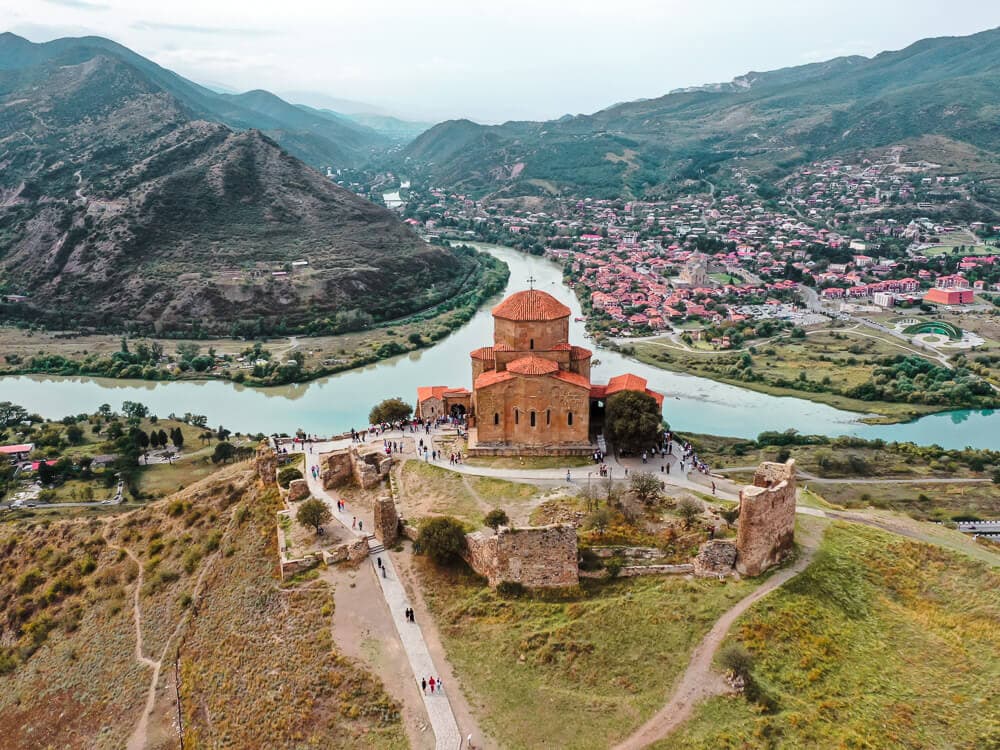
Georgia’s ancient capital from the 3rd century BC to the 5th century AD, Mtskheta is home to the country’s first UNESCO World Heritage Site, the Monuments of Mtskheta.
This is one of the most important places to visit in Georgia in terms of both religion and culture. Svetitskhoveli Cathedral, one of the oldest and most important Orthodox churches, and the stunning Jvari Monastery that overlooks the confluence of the Mtkvari and Aragvi rivers, are both located here.
Mtskheta is a short 45-minute drive from Tbilisi, so to make it a full day trip, it’s usually paired with a visit to Gori and Uplistsikhe.
Gori is a small city famously known for being the birthplace of Joseph Stalin, who is remembered in an oh-so-Soviet museum dedicated to his life. Uplistsikhe is Georgia’s oldest cave city and an impressive introduction to the country’s medieval history and the legacy of the much-beloved Queen Tamar.
Recommended reading:
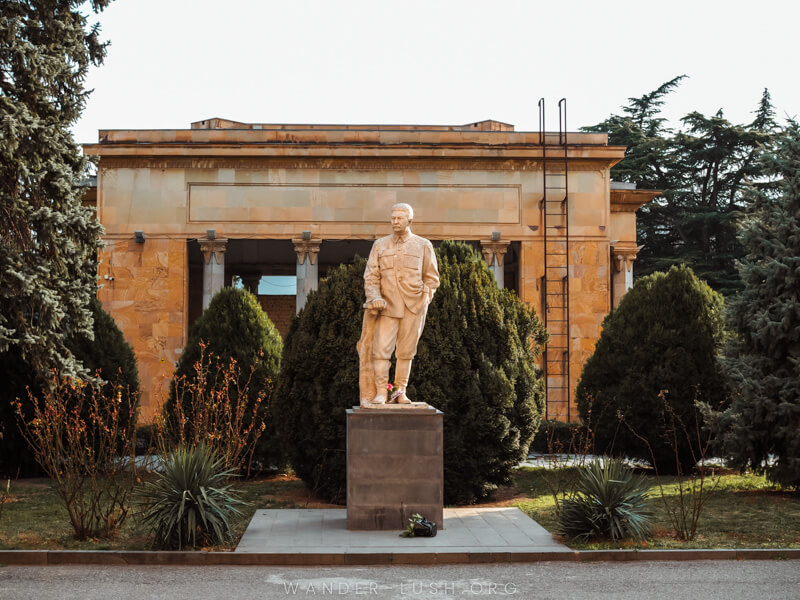
How to do a Mtskheta, Gori & Uplistsikhe day trip from Tbilisi
You have three options here: Join an organised day tour from Tbilisi, hire a private driver, or go DIY by marshrutka.
An organised tour is the most time-efficient option, but you don’t get much flexibility. In Gori, guides tend to focus exclusively on the Stalin Museum, so you won’t get to see any of the city beyond that. Still, having a guide and guaranteed comfortable transport is the best option for some travellers.
To visit all three in a day, I recommend either this budget-friendly group tour or this flexible private tour. Both visit Mtskheta (including Jvari), Gori and Uplistsikhe, with a stop for lunch in either a local home or restaurant.
If you prefer to go in-depth on Mtskheta, this private half-day tour with Friendly.ge can’t be beat. I have done this itinerary myself and it was absolutely wonderful. It even includes the Chronicles of Georgia. Remember to use WANDERLUSH for 10% off.
Doing this trip DIY by marshrutka is possible, but it will be a bit rushed. I would recommend eliminating Mtskheta (you can visit Jvari and/or Svetitskhoveli on the way to Kazbegi instead) and focusing just on Gori and Uplistsikhe. If you want to try this day trip DIY, jump to full transport instructions in the 2-week itinerary here.
The better option in my opinion is to hire a car and driver for the day through GoTrip. You won’t have a guide, but you will have a lot more flexibility to depart Tbilisi when you want, explore Gori at your own pace, and make extra stops wherever you like.
This example itinerary I designed for Mtskheta, Gori and Uplistsikhe starts from a very affordable $45 per car, inclusive of transfers to and from your front door in Tbilisi. You can design your own route with different stops using the GoTrip platform.
Days 4 & 5: Sighnaghi & Kakheti wine region
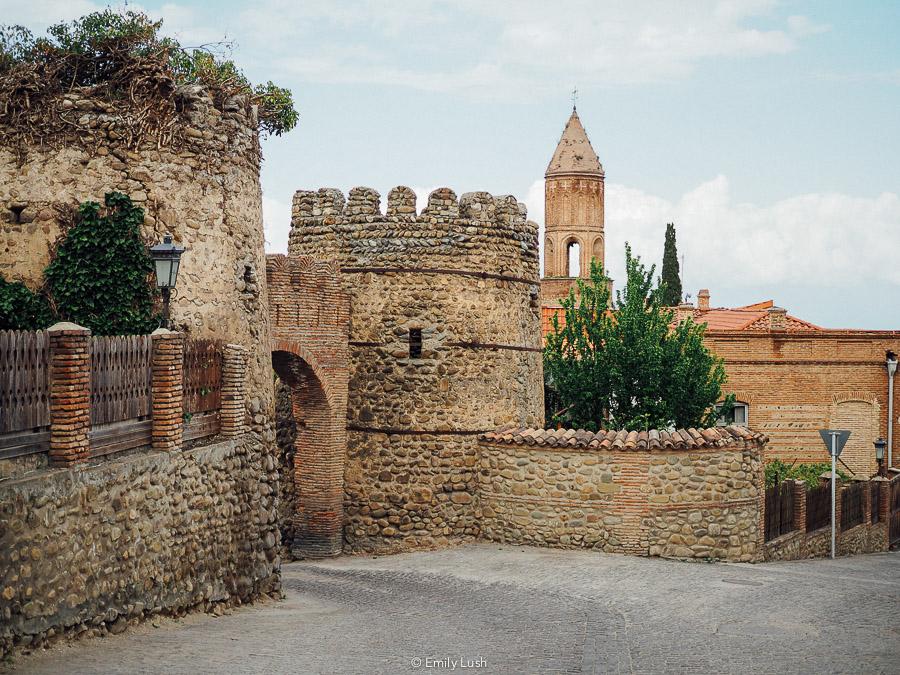
Now that you’ve experienced the best of the capital and its surrounds, it’s time to escape Tbilisi and head east to Kakheti, the country’s most productive wine region. The Alazani Valley is a stunning landscape of vineyards and mountain-top churches.
You could easily spend a week or more travelling the tributaries of Kakheti’s Wine Route, visiting the different family-run maranis (cellars) that still make wine the old-fashioned way in clay qvevri and the many larger commercial vineyards. With two full days, you can see a good selection of the region’s most important churches and indulge in a healthy number of wine tastings.
Sighnaghi, the most charming town in the wine region, or Telavi, the biggest city and transport hub, are both ideal places to stay. There are plenty of guesthouses that specialise in good old-fashioned hospitality (and home cooking), so you have that to look forward to on your first night outside the capital.
If boutique is more your style, stay on the vineyards in one of Kakheti’s splendid wine chateaus. The Radisson Tsinandali Estate just outside Telavi is my personal favourite (read my write-up of the Radisson here) and every bit worth the splurge if only for the buffet breakfast!
In Sighnaghi, climb the City Walls, visit the local museum to see the exhibit of Pirosmani paintings (Georgia’s favourite artist was born in a nearby village), walk to the exquisite Bodbe Monastery, and drink in the panoramic mountain views from any of the restaurants and wine bars in town. On a clear day, you can see across the valley all the way out to the Greater Caucasus.
Recommended reading:
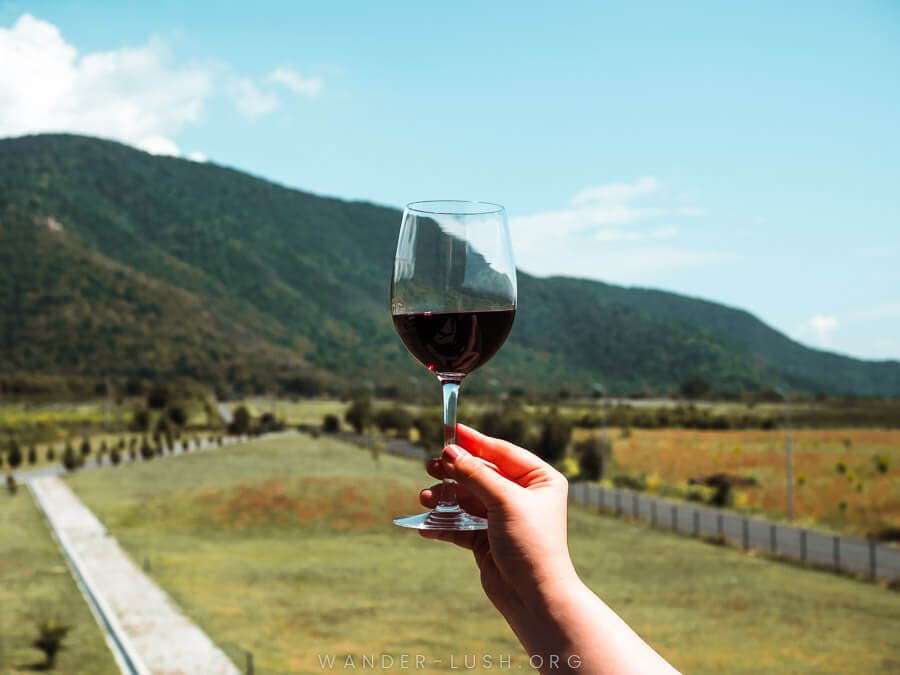
Where to stay in Sighnaghi
For this itinerary, I recommend staying in Sighnaghi rather than in Telavi. Sighnaghi is the more ‘atmospheric’ of the two major hubs in Kakheti and has a good range of comfortable guesthouses.
Telavi has more boutique hotel offerings so if that’s more your style, you might consider staying there instead. Seventeen Rooms and Communal Hotel are my personal favourites.
Budget-friendly guesthouse: Zandarashvili Guest House is a typical family-run guesthouse that’s been welcoming tourists for years. Rooms set over the family’s three-level home are all comfortably decorated and spotlessly clean. Mum cooks, dad drives (you can hire him for the day to take you around Kakheti), and son David plays the role of toastmaster at their nightly supras.
Ranch: If you don’t mind staying a little further from the centre of Sighnaghi, Lost Ridge Inn is one of the coolest accommodations in Kakheti. Rooms are thoughtfully decorated and all have a garden-facing balcony. There’s a restaurant and even a brewery onsite – and they can organise horseback riding tours around the valley. You’ll need a taxi to get here from the centre of town because the ranch is located behind Bodbe Monastery.
Click here to check rates & availability on Booking.com or read my full review of Lost Ridge.
→ Find plenty more options in my Kakheti Accommodation Guide.
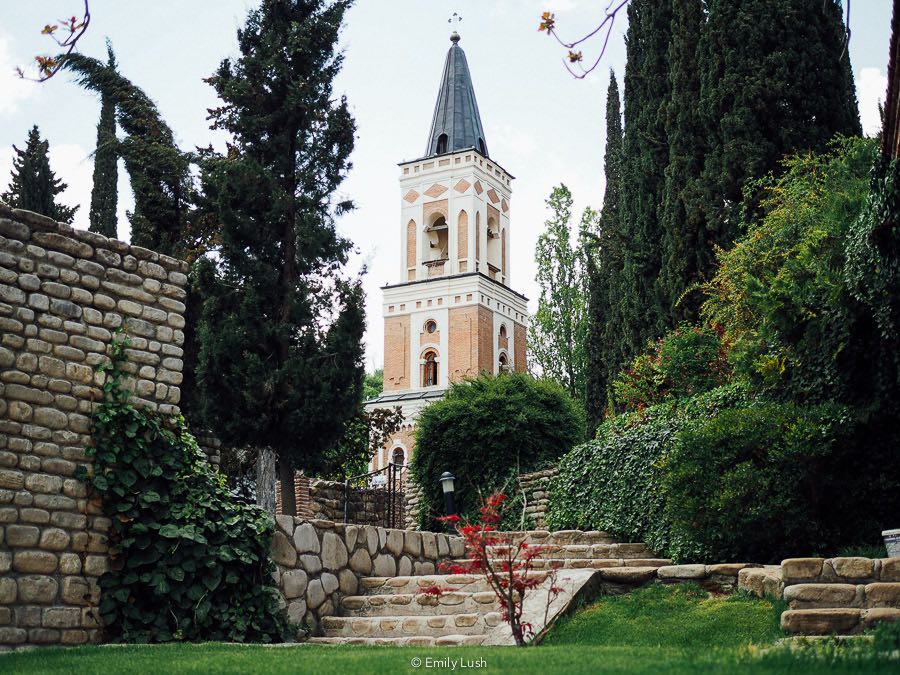
How to get to Sighnaghi from Tbilisi
Sighnaghi and Kakheti Region in general is very easy to get to from Tbilisi with either a marshrutka or shared taxi. Vans depart throughout the day (roughly every 60-90 minutes) from the bus station near Samgori Metro. Shared taxis leave on demand from the street alongside Isani Metro Station.
One thing to be aware of is that there are two possible routes drivers may take. It’s faster to take the Kakheti Highway rather than the Gombori Pass through Telavi, so try to make sure your driver is heading this way.
The first marshrutka is scheduled to leave Tbilisi at approximately 8am. Tickets cost around 10 GEL, and the journey takes 2-2.5 hours via the Kakheti Highway.
A seat in a shared taxi from Isani Metro Station costs around 15 GEL per person. Travel time is slightly faster, and the driver will drop you off closer to your accommodation in Sighnaghi rather than at the bus station.
→ For updated schedules and fares, see my full guide to travelling between Tbilisi and Kakheti.
How to get around Kakheti & travel the Wine Route
The wineries and churches around Sighnaghi are spread out across the valley so you really need your own car to explore the area properly.
The easiest option is to organise a driver for the day through your guesthouse, which you can either do in advance or during your stay. This should cost somewhere in the neighbourhood of 50-60 GEL per person for a full day depending on the number of people you have and how far afield you’re going. It’s cheaper if you pool with other travellers, so you might want to wait until the day and see who else is up for a road trip.
Normally your host will recommend a standard route, but you can always make special requests if there’s a particular winery or monastery you want to see (or skip).
If you want a more intimate experience, I suggest booking a day tour with a reputable company. I use and recommend Eat This! Tours, a small outfit that specialises in family wineries and creative itineraries. They have two single-day tours that focus on Sighnaghi and Telavi, with a good balance between wine tastings, supra feasts and other cultural activities. Pick up/drop off from your accommodation in Kakheti can be arranged.
Check the programs here on the website, and use the promocode WANDERLUSH to get 5% off your booking.
Days 6 & 7: Georgian Military Highway & Kazbegi
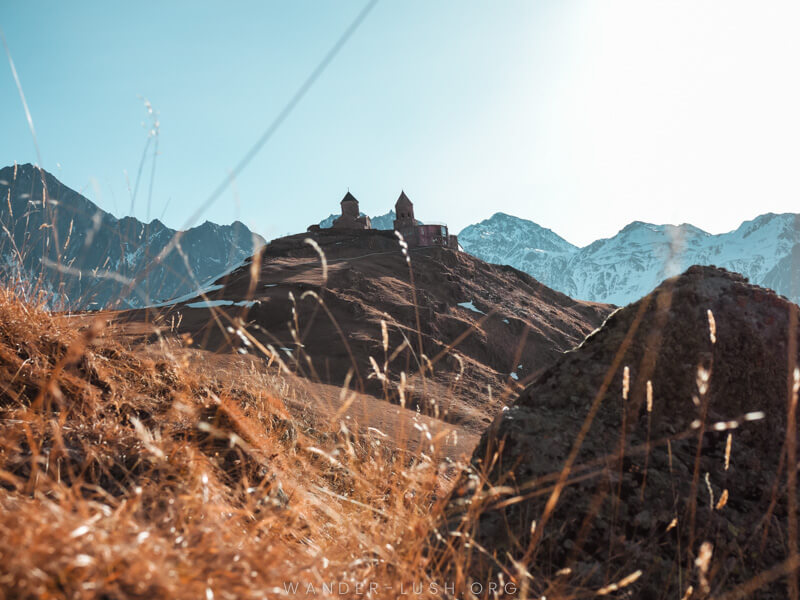
It wouldn’t be a trip to Georgia without an up-close look at the Greater Caucasus mountains. Just three hours by road from Tbilisi, the town of Kazbegi (Stepantsminda) is the most convenient place to immerse yourself in picturesque scenery and do a day trek or two. The Alps without the crowds (or the price tag), this is one of the most beautiful and underrated mountain regions in Europe.
Gergeti Trinity – arguably Georgia’s most iconic Orthodox church – is perched in the hills above town against the snowy peak of Mount Kazbegi. End your Georgia itinerary on a high (literally) by hiking up to the church from town (just make sure you follow the right trail – directions here).
This is one of my absolute favourite things to do in Georgia, especially when you treat yourself to lunch at Rooms Kazbegi afterwards.
The road that links Tbilisi and Kazbegi (and continues up into Russia) is an attraction in and of itself. There are a dozen or so places to stop along the Georgian Military Highway, ranging from Soviet mosaic monuments to scenic viewpoints, medieval churches, and even a small village that some believe is the birthplace of khinkali!
You really want to take your time on this route, so set aside a full day to make the most of it. Hire a car and driver (details below) so that you can make as many stops as possible.
Recommended reading:
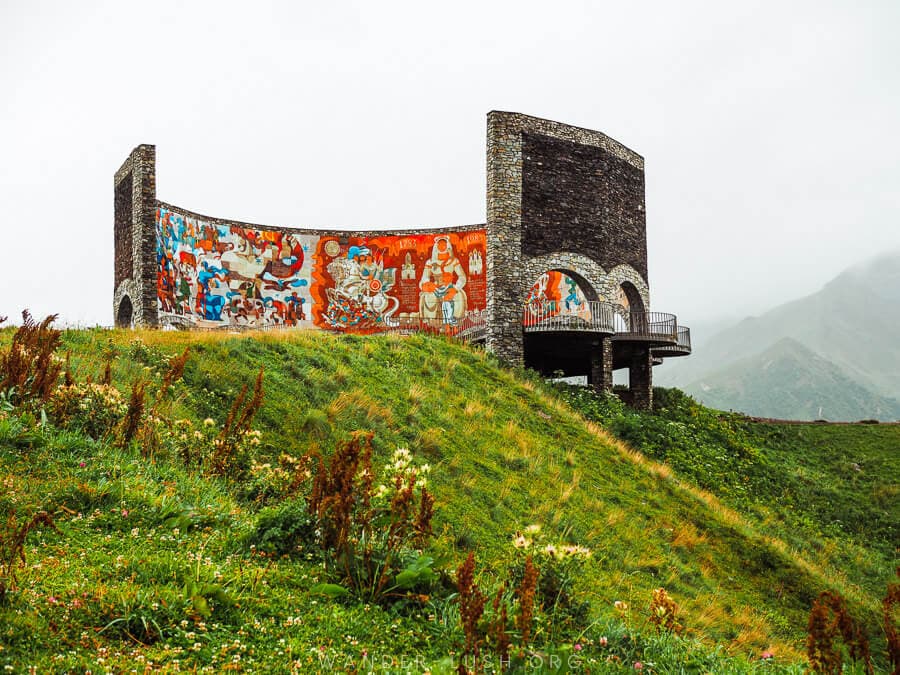
How to travel the Georgian Military Highway to Kazbegi
This is the one route I definitely recommend hiring a car and driver for. There are lots of places to see along the Georgian Military Highway, and if you’re travelling by marshrutka, you simply won’t get a chance to stop.
GoTrip is the most convenient way to find a driver. If you’re coming from Sighnaghi, you should organise for your driver to pick you up from your guesthouse as early as possible. Take the (newly sealed) backroad through Tianeti, stopping off at the cyan-domed Kvetera Fortress Church on the way.
All up, the journey up to Kazbegi takes the better part of 6 hours without stops – so I would give it 8-9 hours in total.
A flexible transfer with GoTrip from Sighnaghi to Kazbegi via Telavi, Alaverdi Monastery and the GMH – with as many stops along the way as you like – starts from 90 USD per car. Customise your own itinerary and book here.
Where to stay in Kazbegi
Budget guesthouse: Red Stone Guest House is a lovely little family-run place near the trailhead to Gergeti Trinity. The home-cooked breakfast here is one of the best I’ve had anywhere in Georgia – I’ll never forget sitting in the tiny kitchen while the owner cooked us a magnificent meal on her tiny gas stove. If you’re doing the hike, she simply won’t let you leave without a stash of khachapuri to take with you.
Click here to check rates & availability on Booking.com.
Mid-range hotel: Hotel Stancia offers minimalist Scandi-style rooms in a very convenient location opposite the bus station in the centre of town. The onsite restaurant is really good. Think of it as a budget version of Rooms.
Click here to check rates & availability on Booking.com.
Boutique hotel: Rooms Kazbegi is probably Georgia’s most iconic accommodation and is definitely worth the splurge. Set inside a renovated sanatorium, every little detail is on-point – right down to the outdoor hot tubs. The verandah offers one of the best views of Kazbegi. The only downside is that it’s a bit of a walk from the centre of town. Even if you don’t stay here, it’s worth visiting for a meal at the restaurant.
Click here to check rates & availability on Booking.com.
If A-frame is more your style, there are some stunning luxury mountain cabins and bungalows in and around Kazbegi. Here are my favourite mountain cabins in Georgia.
→ Find plenty more accommodation recommendations in my guide on where to stay in Kazbegi.
When it’s time to say farewell to Georgia, head back to Tbilisi by marshrutka or taxi. If your flight leaves from Kutaisi, transfer directly to Kutaisi Airport via bus from Tbilisi.
Two weeks in Georgia itinerary
Two weeks is enough time to explore both Eastern and Western Georgia in some detail. You won’t see everything, but you will get a small taste for the regions.
For this itinerary, I’ve switched things around to visit Kakheti towards the end of the trip because it makes more sense logistically. If you prefer to visit the wine region on day 3 as in the previous itinerary, you can easily adjust this.
I’ve also chosen to leave out Batumi as you need a full day to get to the Black Sea. I personally love Batumi and Adjara region, but I don’t consider it a must-see if you only have 14 days in Georgia. If you really want to, you could trim a day off Kutaisi and swap out Zugdidi for 2 days in Batumi instead.
This route builds on the previous 7-day itinerary. Additions are bolded:
Tbilisi – [David Gareja & Udabno] – Mtskheta, Gori & Uplistsikhe – Kutaisi, Chiatura & Tskaltubo – Mestia & Ushguli – Zugdidi – Sighnaghi & Kakheti – Kazbegi – Tbilisi
- Days 1 & 2: Tbilisi – overnight in Tbilisi
- Day 3: Day trip to David Gareja & Udabno – overnight in Tbilisi
- Day 4: Mtskheta, Gori & Uplistsikhe – overnight in Gori
- Days 5 & 6: Kutaisi, Chiatura & Tskaltubo – overnight in Kutaisi
- Days 7, 8 & 9: Mestia & Ushguli – overnight in Mestia
- Day 10: Zugdidi – overnight train to Tbilisi
- Days 11 & 12: Sighnaghi & Kakheti wine region – overnight in Sighnaghi
- Days 13 & 14: Georgian Military Highway & Kazbegi – overnight in Kazbegi
Days 1 & 2: Tbilisi
Refer to days 1 & 2 of the one-week itinerary above.
Day 3: Day trip to David Gareja & Udabno
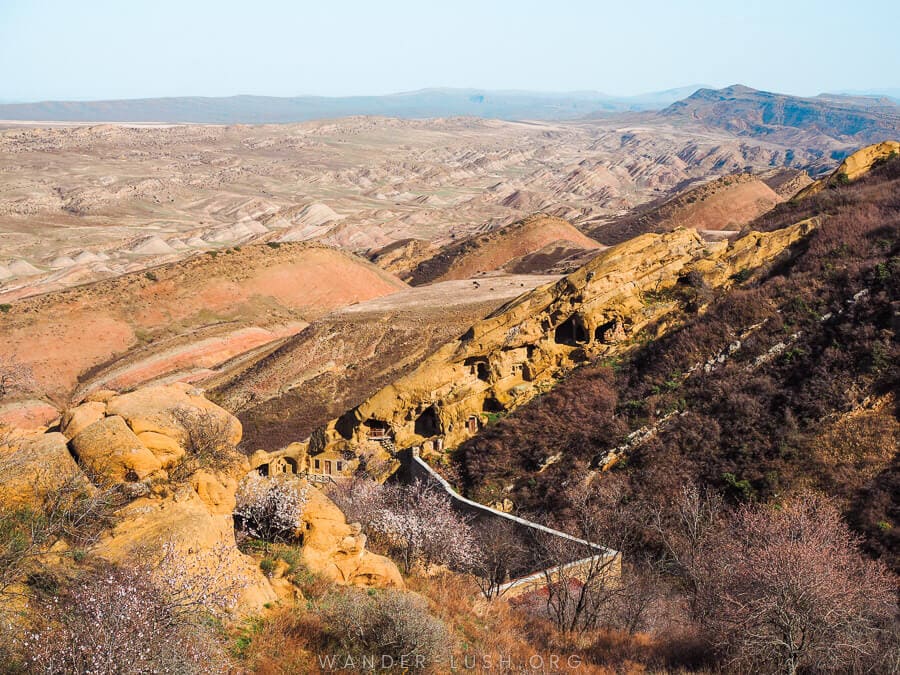
David Gareja and Udabno is probably my favourite day trip from Tbilisi.
The David Gareja cave monasteries are a set of religious sanctuaries composed of chambers and cloisters hewn from rock. The most famous, Udabno Monastery and Lavra Monastery, straddle the border between Georgia and Azerbaijan, and also house a collection of important religious frescoes painted directly onto rock.
As of 2024, the complex is partially closed due to an ongoing border dispute. But the area is safe, and it’s still worth visiting in my opinion.
The semi-desert around Udabno is absolutely unreal. Unmarked hiking routes can be found in the rainbow hills, a wild landscape of multi-coloured striations created by mineral deposits. It’s best to avoid visiting this area in summer as venomous snakes are common.
Recommended reading:
How to do a David Gareja day trip from Tbilisi
In the absence of a marshrutka service, there are two ways to get to David Gareja from Tbilisi: Either by joining an organised day trip, or by using the Gareji Line transfer.
Gareji Line is the best option for budget travellers or anyone who is content with just visiting the main monastery. It is essentially a shuttle van that runs between Tbilisi and David Gareja, with a stop for dinner on the way back at the popular Oasis Club.
Vans run every day during high season (starting from May 1) and on demand in shoulder/low season. The cost is 40 GEL per person. More details can be found on their Facebook Page.
If you want to visit the monasteries with a guide and explore more of Udabno, including the rainbow hills, you will need to either hire a car and/or driver, or more conveniently, join an organised day tour from Tbilisi.
There are several different itineraries that combine a visit to David Gareja with either hiking in Udabno or a wine tasting in Sighnaghi. My top choice is the off-road group tour with Friendly.ge, which pays a visit to Natlismtsemeli Monastery – a lesser-seen but very impressive cave temple. Remember to use WANDERLUSH to save 10% on your booking.
Day 4: Mtskheta, Gori & Uplistsikhe
Since Gori is located between Tbilisi and Kutaisi, I suggest spending a night here as you transit from east to west rather than visiting as a day trip like I recommended for the one-week itinerary.
The easiest option is to book a one-way transfer with GoTrip (Tbilisi-Mtskheta-Uplistsikhe-Gori) so that you can leave your bags in the car while you explore Mtskheta and Uplistsikhe. This itinerary I created starts from $45/car.
Once in Gori, use your extra time to explore the city beyond the Stalin Museum, starting with the unexpected old town, and the Great Patriotic War Museum, which chronicles the city’s experience of the South Ossetian conflict in 2008. Finish with sunset at Gori Castle and dinner at Shin da Gori.
Where to stay in Gori
Nitsa Guest House, run by the lovely Lia, embodies everything I love about Georgian homestays: Bucketloads of hospitality, homemade wine and jam on tap, and extremely comfortable and clean rooms. She really is one of the sweetest hosts I’ve stayed with. During our most recent visit, we stayed up late drinking and dancing with her and her school friends, and I know other guests who’ve been invited back to join in the family wine harvest.
How to get to Mtskheta from Tbilisi
If travelling by public transport: Marshrutka vans pass through Mtskheta on the way to Gori. This is one of the most popular routes from Tbilisi, so vans depart frequently – at least every 30 minutes – throughout the day from Didube Station. Travel time to Mtskheta is 45 minutes and tickets cost 2 GEL.
Note that trains do not stop in Mtskheta – but if you are happy to go straight to Gori from Tbilisi, you can take a Poti or Zugdidi train. The journey time is 1 hour, and tickets cost 12 GEL. Check times and buy tickets on TKT.GE.
How to get to Gori from Mtskheta
To travel onwards to Gori, it’s simply a matter of jumping back on a west-bound van. You can easily flag a marshrutka on the roadside. Travel time is roughly an hour, and tickets cost around 2 GEL.
The van might drop you off on the highway, meaning you’ll need to walk down to the road and jump on a local bus to travel the rest of the way (I had to do this once – it’s quite straightforward, and the driver will help you out). If the marshrtuka drops you at the bus station in Gori, you will need to take a taxi into the centre of town.
How to get to Uplistsikhe from Gori
Uplistsikhe is located 14km (around 20 minutes by road) from the centre of Gori. To get there, you can take a local van from Gori’s Bus Station (see location here) to Uplistsikhe village (around 1 GEL) and then walk 700 m to the cave entry point.
Or you can take a taxi from Gori, which should cost around 40-50 GEL round-trip including wait time. Taxis wait behind the Stalin Museum near the Chinebuli restaurant. Your guesthouse host can usually organise a reliable driver for you.
Days 5 & 6: Kutaisi, Chiatura & Tskaltubo
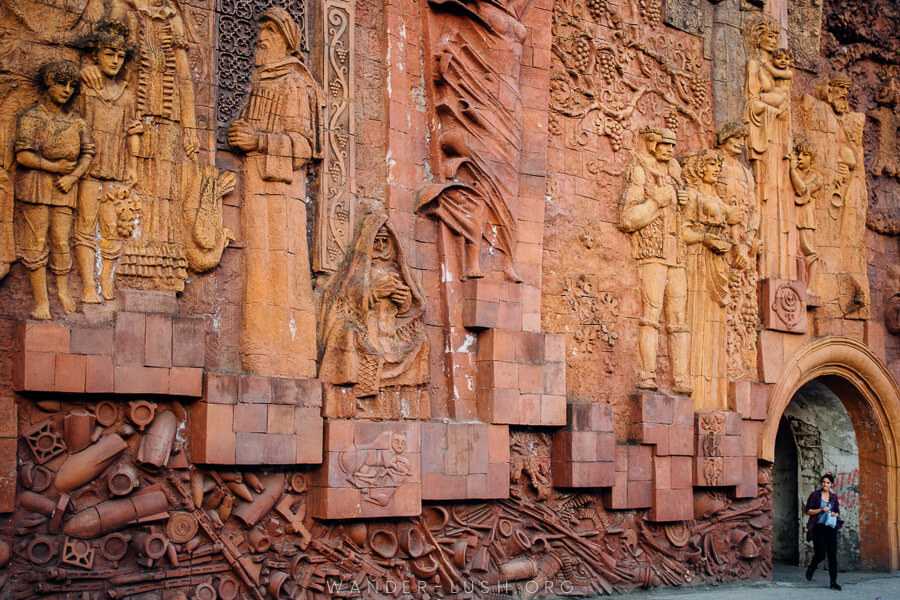
Kutaisi is Georgia’s fourth-biggest city and the main hub in the country’s west. It has a completely different vibe to the capital: it is much quieter, and the lush forests of Imereti give it a unique backdrop. That is one of the main reasons why I chose to move here!
I love Kutaisi, not least of all because there are so many cute restaurants and wine bars around town. UNESCO-Listed Gelati Monastery and Motsameta Monastery, linked by a forest walking trail, are both must-sees – as is watching the sunset from the grounds of Bagrati Cathedral.
In the city centre, the sparkling Colchis Fountain pays tribute to the ancient kingdom that once enveloped Kutaisi, one of the oldest continually inhabited cities in Europe. The synagogues, cable car and bustling undercover market are just a few more of my favourite spots.
Tskaltubo is located 20 minutes by road from Kutaisi and is an ideal side trip. A popular summer retreat during Soviet times, it’s home to a collection of sanatoriums that were used for state-mandated health treatments.
Many of these sanatoriums and bathhouses now lay abandoned – a real playground for urbexers and photographers. You can even visit Stalin’s dacha, his former suite at the old Military Sanatorium and Stalin’s personal bath, which is located inside one of the spas that remains open.
Some of the larger buildings were converted into temporary accommodation for IDPs who fled Abkhazia in the 1990s. When exploring Tskaltubo, be a responsible traveller and keep in mind that many families still live here and that some buildings are off-limits (it’s fairly obvious which ones to avoid).
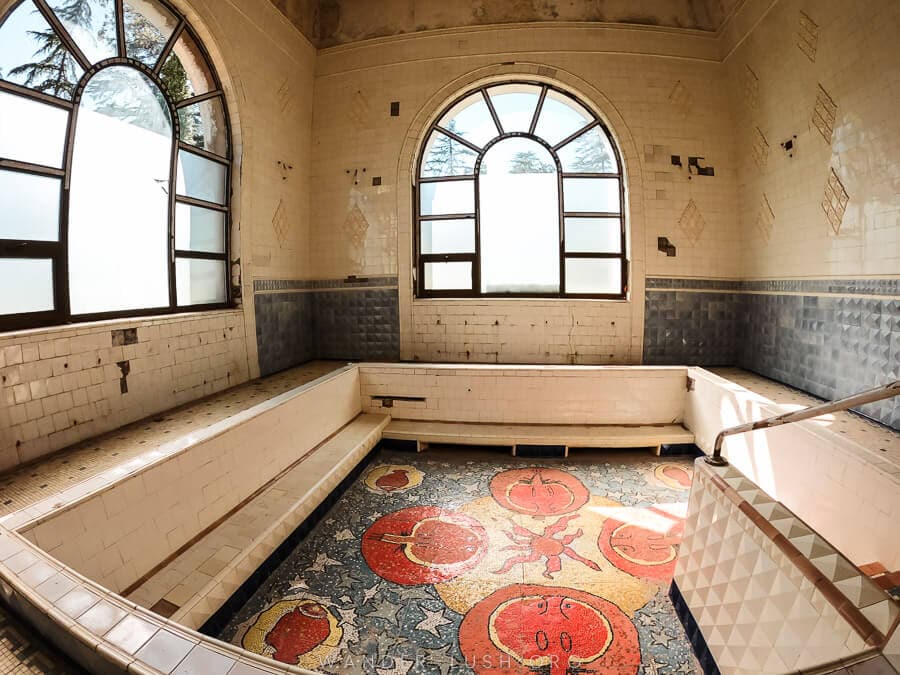
While you’re in Kutaisi, I also suggest taking a full-day trip to Chiatura and Katskhi Column. Chiatura is a small mining city that flourished in Soviet times but has since gone into decline. In the 1950s, the state erected a network of 17 cable cars across Chiatura to ferry workers to and from the manganese mines.
Some of the original cars were still running up until just a few years ago (I was lucky enough to ride on ‘Stalin’s Rope Roads’ back in 2017), but in 2021, they were replaced with a new set of gondolas. If you’re interested in Soviet nostalgia and brutalist concrete architecture, this is the perfect day trip for you.
On the way to Chiatura, stop off at Katskhi Column, a striking monastery that sits atop a tall limestone stalactite.
And if you have time, make a pit-stop in the industrial city of Zestafoni, where you will find some truly remarkable mosaics and a 1930s-era ferroalloy factory.
Recommended reading:
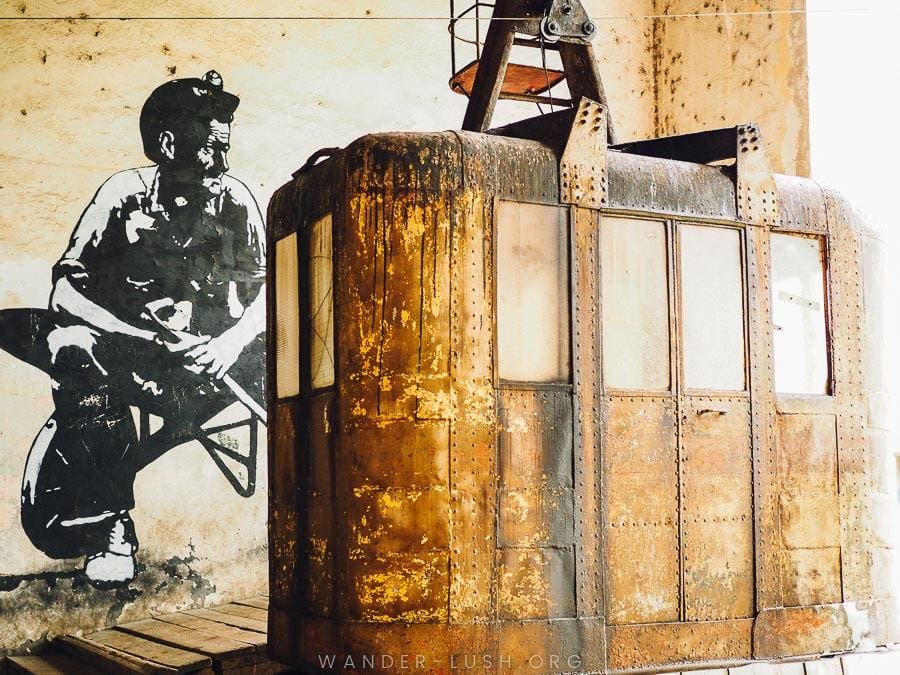
Where to stay in Kutaisi
Budget hostel: The newly re-launched Black Tomato Hostel offers bright and airy dorms plus private rooms with ensuite bathrooms in the heart of Sapichkhia, the former Jewish Quarter. Everything is newly renovated, while antique furnishings give rooms a classic Kutaisi feel. The onsite restaurant, which takes its inspiration from Kutaisi-Jewish cuisine, is fabulous and worth trying for lunch or dinner even if you’re not staying here.
Click here to check rates & availability on Booking.com.
Mid-range hotel: Hotel Newport is located in the old Kutaisi courthouse, directly behind the Colchis Fountain at the entrance to the historic Jewish Quarter. Rooms are compact and tidy, and the onsite restaurant-bar is great (I often eat here). A nice buffet breakfast comes included. Don’t miss out on seeing their rooftop terrace.
Click here to check rates & availability on Booking.com.
Boutique hotel: The recently inaugurated Communal Kutaisi is easily the loveliest hotel in town. Set on historic Tabidze Street, rooms are small but impeccably designed, with elements that channel Old Kutaisi charm. There is a pool out back, and the hotel’s Georgian restaurant, Doli, is the best place to eat in the city.
Click here to check rates & availability on Booking.com.
→ Find more suggestions in my Kutaisi neighbourhood & hotel guide
How to get to Kutaisi from Gori
There are semi-regular marshrutka minivans and shared taxis departing Gori bus station for Kutaisi throughout the day, starting from as early as 9am. Travel time is around 2.5-3 hours, and the fare is approximately 12 GEL.
Kutaisi’s main bus station, where most vans terminate, is located next to the McDonalds on Chavchavadze Avenue, around 4 km from the centre (see location here). City bus #1 will take you from the bus station to the Colchis Fountain for 60 tetri.
How to visit Tskaltubo from Kutaisi
Vans to Tskaltubo depart from the end of the Red Bridge (near the Magnolia Hotel) every 15-20 minutes between 8am and 7pm. Travel time is 25 minutes, and the fare is 2 GEL. When you arrive in Tskaltubo, jump out at the park. Alternatively, a taxi to Tskaltubo costs around 15 GEL when booked through Bolt.
To get back to Kutaisi, just flag down a van travelling the opposite way. The fare is the same.
How to visit Katskhi Column & Chiatura from Kutaisi
There are a dozen daily vans to Chiatura from Kutaisi’s main bus station starting from 7am and departing every 40-60 minutes until 5pm. Drivers normally make a short stop in Zestafoni on the way, so if you want to see the mosaics and architecture in Zestafoni first, jump out here for a walk around.
Drivers can drop you off on the highway at the trailhead for Katskhi Column on request. Travel time is 1.5-2 hours to Chiatura or just over an hour to Katskhi Column. Tickets cost around 8 GEL.
After you’ve visited Katskhi, you can just jump back in a van to continue to Chiatura. See my detailed instructions for visiting Katskhi and Chiatura from Kutaisi for more tips and important information about getting back to Kutaisi at the end of the day.
You can also go further along the same highway past Chiatura to Sachkhere, where there are a few more notable mosaics and a wonderful fortress called Modinakhe (car required). See my guide to Sachkhere here for inspiration.
With a private driver booked through GoTrip, you could quite easily do all five stops in one day. Drive time is around 4 hours return. Here is my Kutaisi-Zestafoni-Katskhi-Chiatura-Sachkhere itinerary.
Optional detour: Skip Svaneti & continue to Racha region
Sachkhere is the starting point for a new high mountain road that goes all the way to Racha region. It is one of the most beautiful drives in the country, especially in autumn.
If you’re searching for an alternative to Svaneti (Mestia and Ushguli) for days 7-9 of your trip, Racha is a terrific choice – it has alpine villages, hiking trails, incredible wine and cuisine, Shaori Lake, Tskhrajvari, and the wonderful small town of Oni with its synagogue.
I recommend booking a driver to take you all the way to Oni via the Alpana-Mamisoni Pass, then basing yourself at the wonderful Family Hotel Gallery. Racha is a bit tricky to navigate without your own car, but host Nika can help you with organising transport and/or hikes.
Days 7, 8 & 9: Mestia & Ushguli
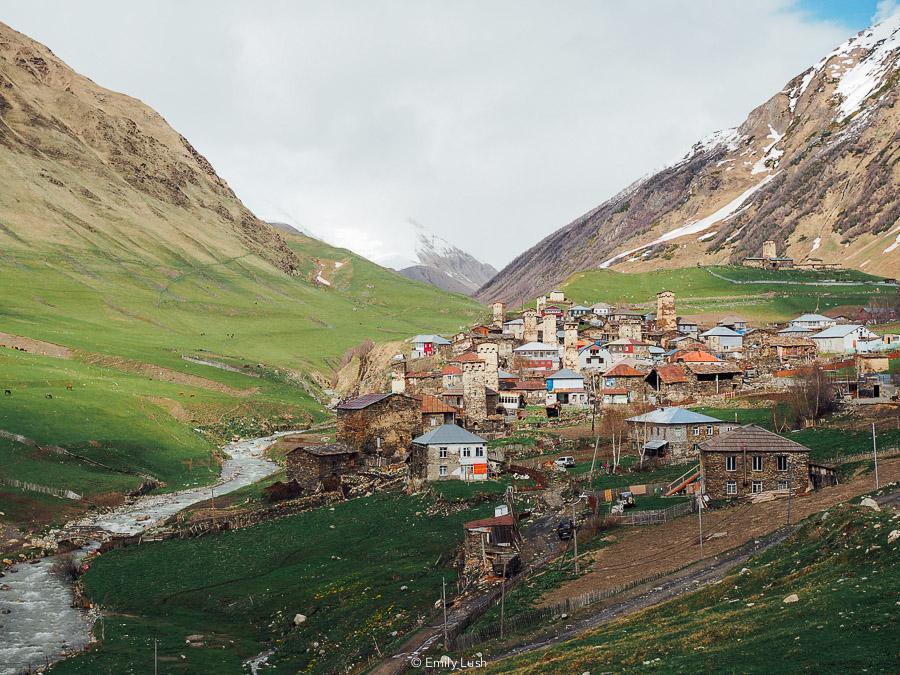
Remote Svaneti Region is one of the most ruggedly beautiful corners of Georgia. Located in the country’s far north-west, the stunning scenery here is matched by a fascinating cultural mix that comes from the diverse ethnic groups who have lived in the mountains and valleys for eons.
Svaneti offers the best mountain hiking in Georgia. You won’t have enough time for the multi-day Mestia to Ushguli trek on this itinerary, but there are a range of alternative day hikes available.
Mestia is the main hub for Svaneti and has a good selection of guesthouses and restaurants, along with frequent transport connections. This is the place to indulge in hearty mountain fare (kubdari beef pie and spiced Svanetian salt are two regional specialties that you must try), and learn about the legendary Svans at the wonderful Svaneti Museum of History and Ethnography.
Ushguli is just a day trip away from Mestia. One of the highest inhabited villages in Europe (by some measures), it’s a UNESCO World Heritage Site recognised for its iconic medieval stone fortified towers. In the village of Chazhashi, more than 200 towers still stand proud today.
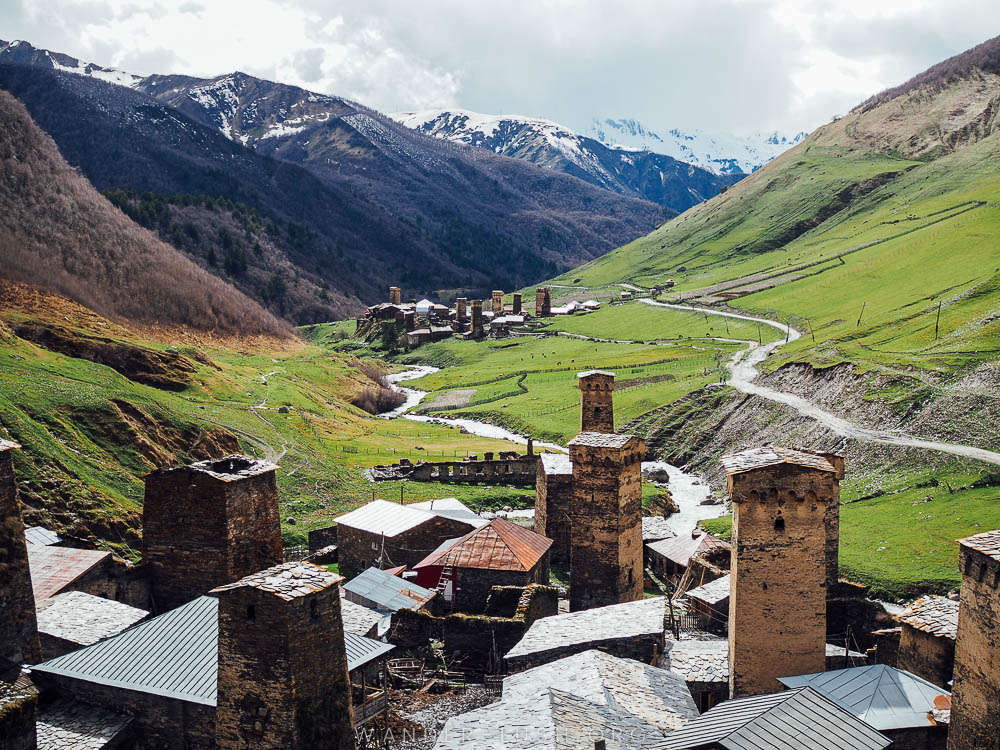
How to get to Mestia from Kutaisi
Kutaisi to Mestia is quite the journey so be prepared for a long and windy day of travel. I highly recommend booking a shared transfer with Budget Georgia – it’s generally a safer and definitely a more comfortable option. Prices start from 80 GEL per person in summer. Mention me when you book to get 10% off.
If you opt for public transport, then depending on the time of year, you might have to change vans in Zugdidi as direct marshrutka vans only tend to run in the high season. This is nothing to worry about though – mention your final destination to your first driver in Kutaisi and they will phone ahead to the next driver to ensure you make the transfer.
Travel time by marshrutka to Mestia from Kutaisi is approximately 5-7 hours. There is one direct van from Kutaisi Central Bus Station at 10am, and the fare is 30 GEL. Alternatively, take a van to Zugdidi (hourly; 10 GEL) and change to a Mestia there.
This road was recently upgraded, but it’s still a nail-biter. If you prefer to go with a driver (not a bad idea, especially in winter), a private transfer with GoTrip starts from 400 GEL.
How to visit Ushguli from Mestia
Ushguli is located 50 km east of Mestia, deeper in the mountains. You can travel between the two by road in around 2 hours. Most people visit Ushguli as a day trip. It’s possible to stay overnight (there are plenty of guesthouses) but in my opinion, a day is enough.
Tourist vans ply this route and there are always a couple of daily departures leaving Mestia at around 9am and returning before nightfall. The going rate for a seat is around 40-60 GEL per person return, and itineraries usually include lunch and a few scenic pit stops on the way to Ushguli.
Your guesthouse owner should be able to phone ahead and save you a seat the day before – or you can try your luck by approaching a driver near the main square (there are usually 4WDs waiting here as well if you prefer to go in a private car).
This road has improved considerably in recent years, but about 10 km is still unpaved. Note that if snow is particularly heavy in winter or if there’s a landslide in spring, the road to Ushguli may be closed for several days or more.
Day 10: Zugdidi
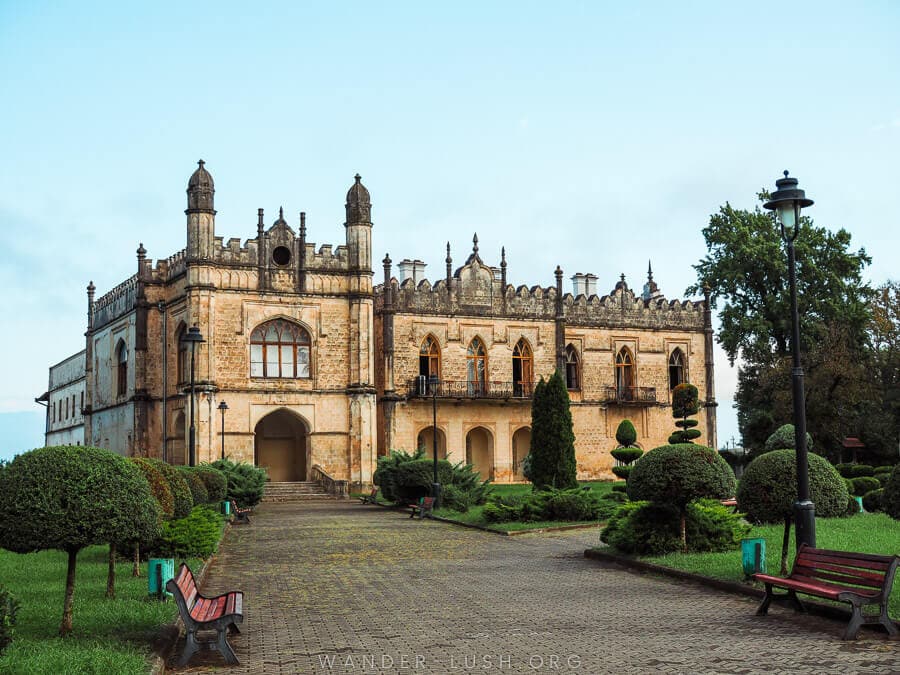
Zugdidi is a convenient place to stop for a few hours on the way down from Svaneti before you cross back into Eastern Georgia.
I have a soft spot for the biggest city in Samegrelo Region, a part of Georgia that’s very culturally distinct from the rest of the country. It also happens to be home to my favourite regional cuisine. Megrelian specialty restaurants such as Diaroni serve up kharcho (rich beef stew with walnuts) and elarji (cheesy cornmeal).
The biggest attraction in Zugdidi (apart from the food) is the Dadiani Palace, a former royal residence-turned-museum that holds a rare Napoleon death mask in its collection (strange, I know).
Zugdidi Botanical Garden, the former palace grounds, is now a beautiful public park. The city’s aristocratic heritage and connection to the French royal family is quite fascinating.
If you have time, take a 20-minute bus ride to Rukhi Castle for a view of Abkhazia before boarding the evening train back to Tbilisi.
Recommended reading:
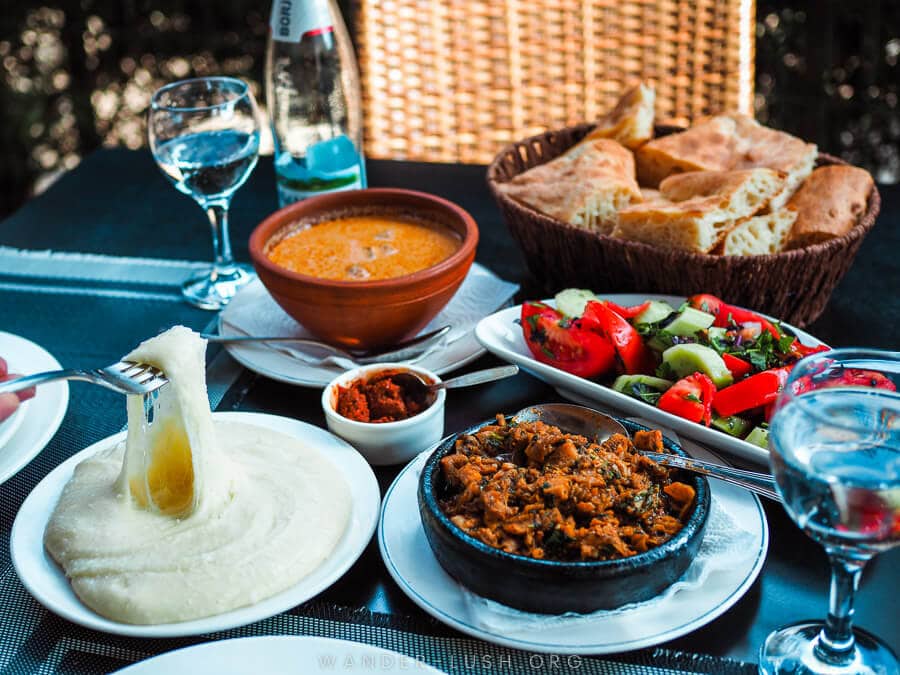
How to get to Zugdidi from Mestia
There are at least three direct vans from Mestia to Zugdidi daily departing from the bus station off Seti Square (see location here). Check times when you arrive in Mestia – the owner of your guesthouse will know. Travel time to Zugdidi is around 4 hours with a stop at Enguri Dam, and the fare is around 40 GEL.
Taking the train from Zugdidi to Tbilisi
The rest of this two week Georgia itinerary is based in the east of the country. You’ll need to transfer through Tbilisi to get to Kakheti, so I recommend taking advantage of the late train to get back to the capital from Zugdidi. This will save you a full day on the road.
An evening train departs Zugdidi at around 5.20pm and arrives in Tbilisi just before midnight. Tickets start from 16 GEL and can be purchased online in advance via TKT.GE.
Spend a night in Tbilisi, then on day 11, take a metro or taxi to Samgori/Isani to catch a marshrutka/taxi straight to Kakheti (the first van of the day is scheduled for 8am).
You will arrive bright and early in Sighnaghi, so you can afford to have a rest morning to recover from the long journey. Make sure you organise an early check-in with your guesthouse in advance.
Days 11 & 12: Sighnaghi & Kakheti wine region
Refer to days 4 & 5 of the one-week itinerary above.
Days 13 & 14: Georgian Military Highway & Kazbegi
Refer to days 6 & 7 of the one-week itinerary above.
Three weeks in Georgia itinerary
Three weeks in Georgia is ideal for travelling at a slightly slower pace. You will have more time up your sleeve for specialty activities such as hiking, and you’ll be able to visit a few of the more remote corners of the country that take longer to reach by road.
This route builds on the previous 2-week Georgia itinerary. Additions are bolded:
Tbilisi – [David Gareja & Udabno] – Mtskheta, Gori & Uplistsikhe – Kutaisi, Chiatura & Tskaltubo – Mestia & Ushguli – Zugdidi – Batumi – Khulo & Upper Adjara – Akhaltsikhe & Vardzia – Borjomi – Sighnaghi & Kakheti – Kazbegi – Tbilisi
- Days 1, 2 & 3: Tbilisi & day trips – overnight in Tbilisi
- Day 4: Day trip to David Gareja & Udabno – overnight in Tbilisi
- Day 5: Mtskheta, Gori & Uplistsikhe – overnight in Gori
- Days 6 & 7: Kutaisi, Chiatura & Tskaltubo – overnight in Kutaisi
- Days 8, 9 & 10: Mestia & Ushguli – overnight in Mestia
- Day 11: Zugdidi – overnight in Zugdidi
- Days 12 & 13: Batumi – overnight in Batumi
- Days 14 & 15: Khulo & Upper Adjara – overnight in Khulo
- Day 16: Akhaltsikhe & Vardzia – overnight in Akhaltsikhe
- Day 17: Borjomi – overnight in Tbilisi
- Days 18 & 19: Sighnaghi & Kakheti wine region – overnight in Sighnaghi
- Days 20 & 21: Georgian Military Highway & Kazbegi – overnight in Kazbegi
Days 1, 2 & 3: Tbilisi & day trips
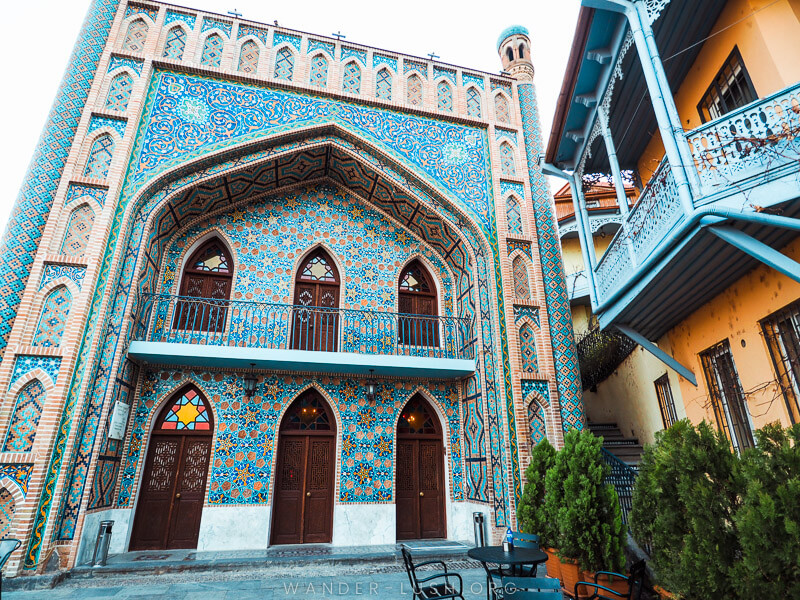
For things to do in Tbilisi, refer to days 1 & 2 of the one-week itinerary above.
This itinerary allows for an extra day in Tbilisi. You might choose to spend it visiting the Chronicles of Georgia and Tbilisi Sea, exploring the outdoor market at Navtlugi and visiting the Stalin Printing House Museum, or by venturing up to the Open Air Ethnography Museum, Turtle Lake, and one of my favourite restaurants in Tbilisi, Rachis Ubani.
Or you might choose to add on an extra Tbilisi day trip instead.
Day 4: Day trip to David Gareja & Udabno
Refer to day 3 of the two-week itinerary above.
Day 5: Mtskheta, Gori & Uplistsikhe
Refer to day 3 of the one-week itinerary above.
Days 6 & 7: Kutaisi, Chiatura & Tskaltubo
Refer to days 5 & 6 of the two-week itinerary above.
Days 8, 9 & 10: Mestia & Ushguli
Refer to days 7, 8 & 9 of the two-week itinerary above.
Day 11: Zugdidi
For things to do in Zugdidi, refer to day 10 of the two-week itinerary above.
For this itinerary, I recommend spending the night in Zugdidi before you continue down the coast to Batumi.
Where to stay in Zugdidi
Guesthouse: Casa de Khasia is a gorgeous boutique guesthouse that’s run by a local couple who are extremely active in advancing the rights of Abkhaz IDPs and promoting Zugdidi as a tourist destination. Rooms are large and beautifully furnished, and the outdoor common spaces are delightful. Breakfast is included.
Click here to check rates & availability on Booking.com.
Guesthouse: Another guesthouse option in Zugdidi, Elco is conveniently located near the railway station. The owners are beyond friendly (I was invited to dinner when I stayed with them), and the rooms are really above and beyond, with tidy ensuites and a full coffee set-up for preparing your morning brew.
Optional detour: Poti & Kolkheti National Park
Located north of Batumi, the Black Sea city of Poti, also part of Samegrelo region, is a short 60-minute drive from Zugdidi. If you are more interested in nature and history, you might like to spend a day here on your way down to Batumi.
The site of an important sea port, Poti has beautiful turn-of-the-century architecture, a heritage lighthouse, and some fun street art. Just outside the city, Kolkheti National Park is a UNESCO World Heritage Site where you can take a boat trip across Palistomi Lake and explore an exceptional landscape of wetlands and mangrove forests.
See my full guide to Poti for ideas, and my Kolkheti National Park guide for information about booking a boat excursion.
Days 12 & 13: Batumi
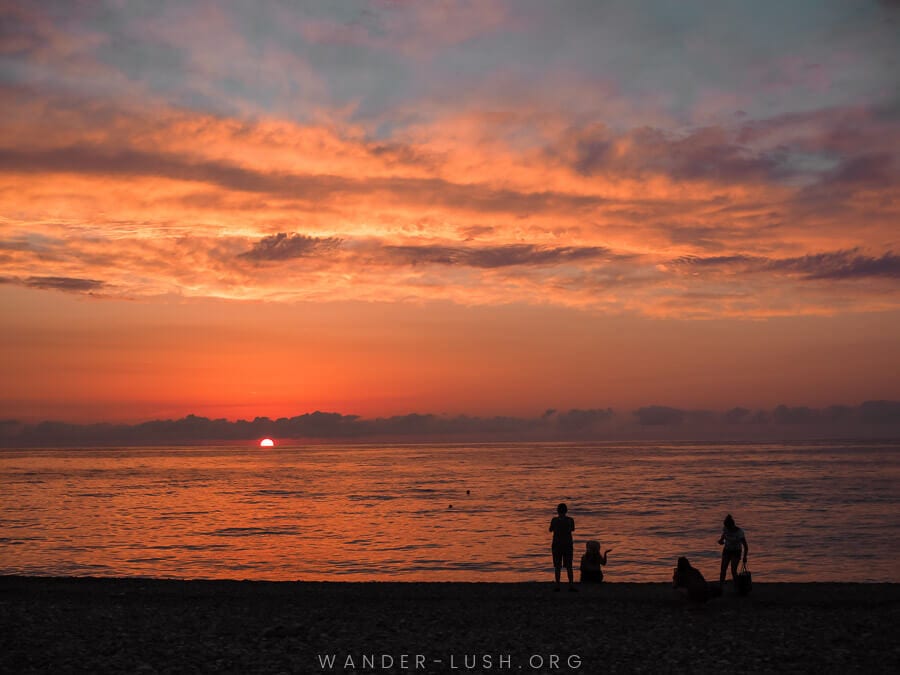
Batumi is Georgia’s biggest Black Sea resort city. I will be the first to admit that it’s not everyone’s cup of tea (it wasn’t mine either at first) – but with three weeks in Georgia, it would be a shame not to visit the Black Sea region, which is very important to Georgian culture.
Adjara (the region Batumi is part of) is another culturally distinct pocket of the country with a palpable Turkish influence and yet another scrumptious local cuisine to its name. Adjaruli Khachapuri – that iconic boat-shaped bread oozing with molten cheese, butter and a gooey egg – was born in Adjara.
Batumi revolves around the stony beachfront and Batumi Boulevard, a scenic park that traces the sealine and has been a fixture of the city since 1881. Hire a bike and cycle along the foreshore – all the way to Sarpi and the Turkish border if you’re game.
The Batumi Botanical Garden was the largest in the Soviet Union and is a must-visit for easy hiking and sea views. Eat lunch at the Fish Market, walk the old town, then take a bus down the coast to Gonio Fortress or north to Petra Fortress, Seaside Shukura at Tsikhisdziri Hidden Beach and the magnetic black sand beaches around Ureki.
Some of Georgia’s best national parks (and the country’s newest UNESCO World Heritage Site, the Colchic Rainforests and Wetlands), are a day trip away. Go hiking in Mtirala National Park or visit the more-spectacular and more-remote Machakhela, which straddles the Turkish border.
Admire Batumi’s street art and imaginative architecture, then finish your day with sunset drinks at high-rise Kartuli. As long as you’re visiting outside of peak summer season, you’ll no doubt find plenty of reasons to love Batumi.
Recommended reading:
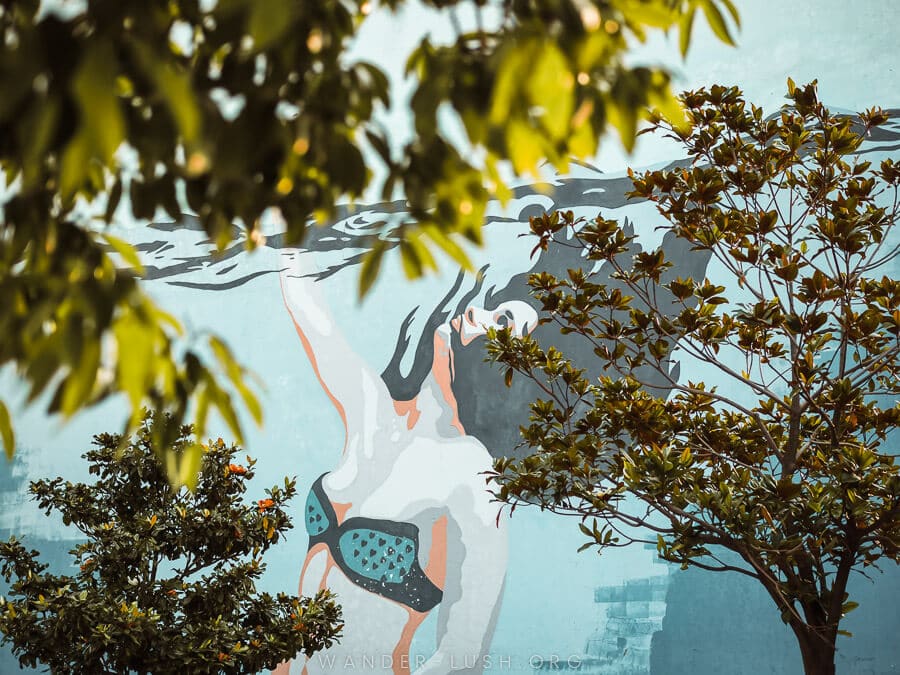
How to get to Batumi from Zugdidi
There are at least eight daily vans to Batumi departing from the bus depot near Zugdidi Railway Station (see location here). Travel time is 3 hours and the fare is around 25 GEL. If there’s no van available when you arrive at the station, you can always transfer through Poti (a charming city in its own right, see the optional detour described above).
The journey down the Black Sea Coast is a real treat. Grab a seat on the righthand side of the van for the best views.
Days 14 & 15: Khulo & Upper Adjara
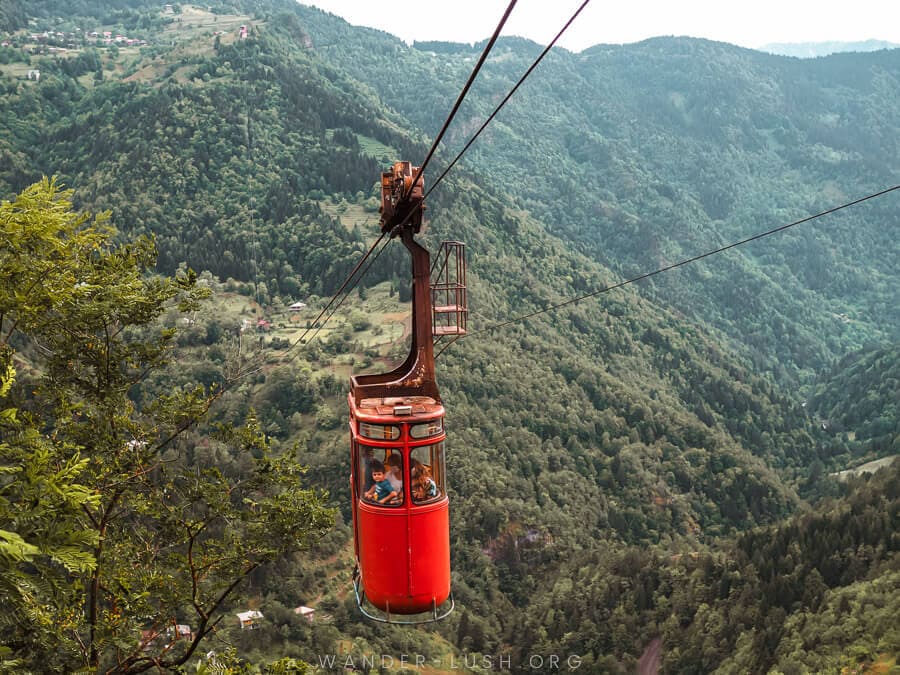
Upper Adjara is the mountainous region east of Batumi. Majority Muslim, it’s known for its opulent painted mosques. In summer, shepherds come here to pasture their flocks. In winter, picturesque mountain towns dotted with sweet cabins transform into ski slopes.
Khulo is not the biggest town in Upper Adjara, but it’s definitely my favourite place to base your stay. It offers a good selection of accommodation and a couple of reliable food options (Restaurant ABX is my top pick).
As you will see, they do things a bit differently here – one of the ways to get around is by using a cable car to travel across the valley! Built in 1985, it still uses all its original mechanics. The line is just under 2 km, making it the second-longest single-span cable car in Europe.
I have done this trip twice now and let me tell you, it is mighty nerve-racking. Taxis are available from Khulo to take you to Glamping Tago if you prefer (see below).
Where to stay in Khulo
Guesthouse: Hotel Khulo Inn is a short walk from the centre of town and boasts direct views of the valley and Tago cable car. Rooms are new and very comfortably furnished, and the owners – a young local family – are incredibly gracious. I stayed here recently and rate it highly.
Click here to check rates & availability on Booking.com.
Glamping: For something special, Upper Adjara has a few ‘glamping’ luxury tents and geodesic domes. Glamping Tago is located in the small village on the opposite side of the valley and can be reached via cable car from Khulo. The spectacular mountaintop location makes it one of the most memorable accommodations in Georgia.
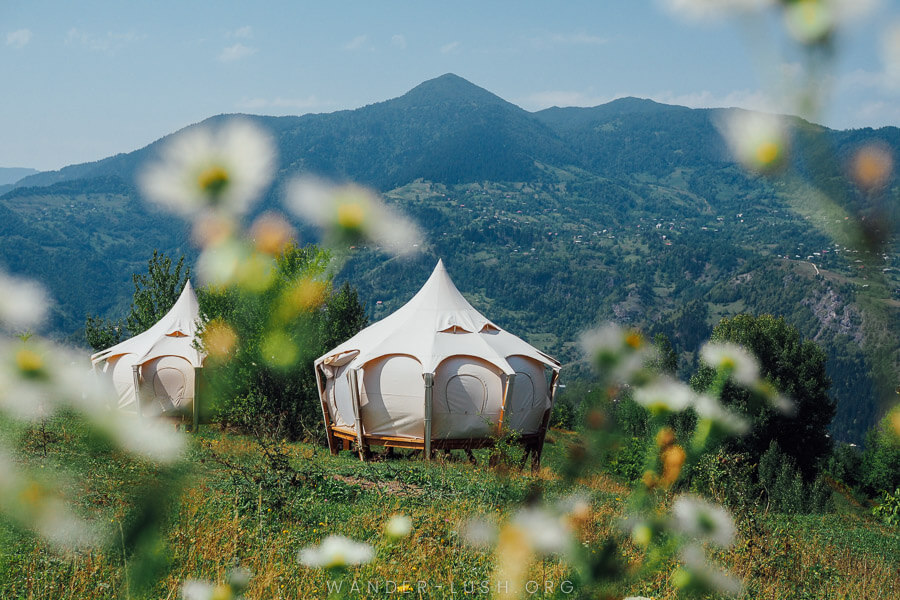
How to get to Khulo from Batumi
Marshrutka vans bound for Khulo and the villages in Upper Adjara leave every hour or so from Batumi’s old bus station (see location here). Travel time is 2.5 hours and tickets cost 10 GEL. Alternatively, a taxi costs around 150 GEL. Hotel Khulo Inn and Glamping Tago both offer this service.
The road into the mountains is windy and a bit rough, so if you suffer from motion sickness remember to have your medication on-hand.
Day 16: Akhaltsikhe & Vardzia
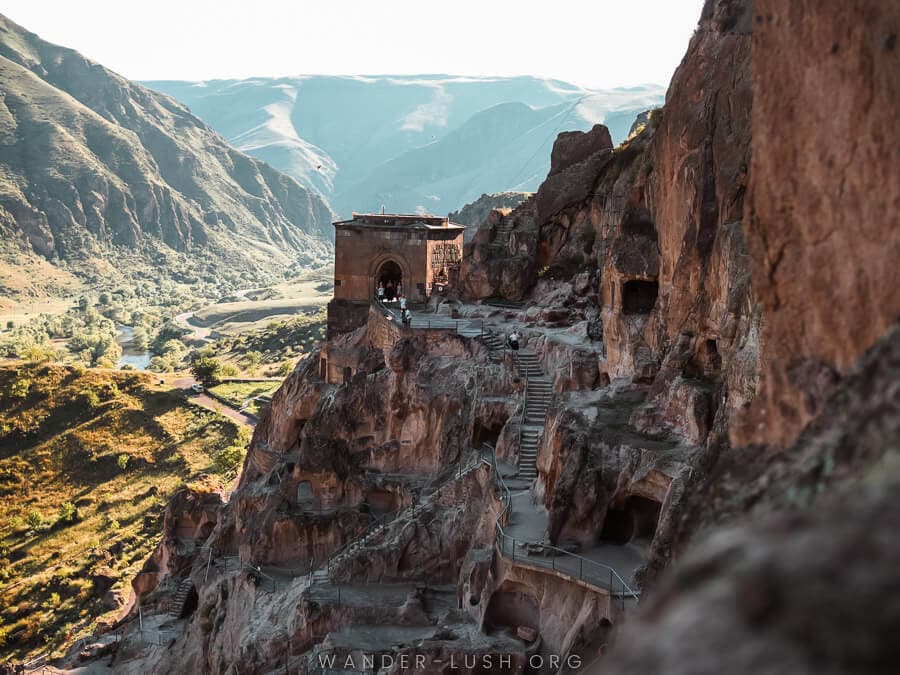
Akhaltsikhe is a small city in Georgia’s Samtskhe–Javakheti region, a culturally diverse part of the country that is loaded with historical monuments and archaeological sites. The most famous of them all is of course Vardzia, Georgia’s biggest cave city, which lies just east of Akhaltsikhe.
Composed of more than 4,000 individual cells and chambers hewn from a sheer rock wall, it cuts an impressive figure. It’s enthralling to explore on foot, especially when you have a guide to point out the copper pipes, bread ovens and clay qvevri – ancient amenities that once supported a large community of resident monks.
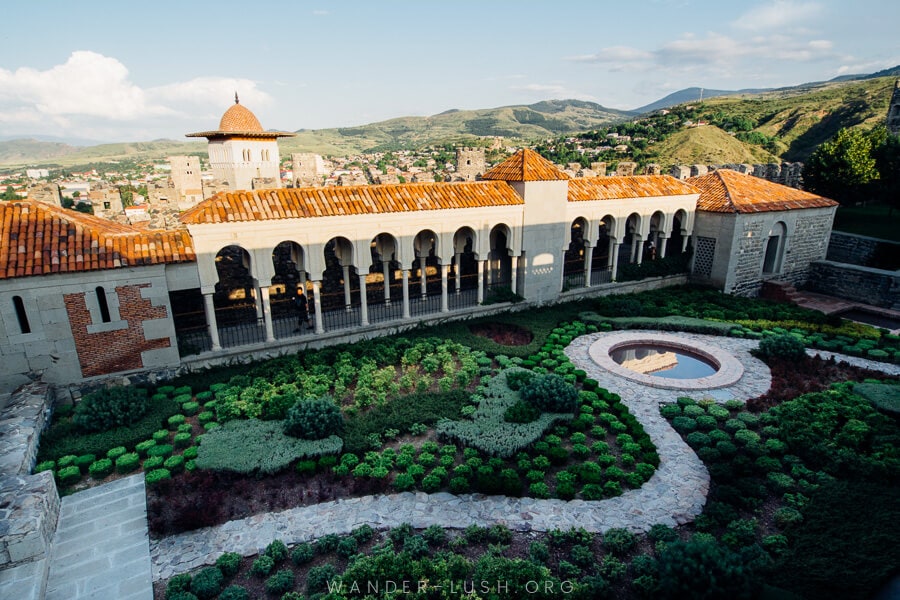
The biggest attraction in Akhaltsikhe city is Akhaltsikhe Fortress, AKA Rabati Castle, a massive fortification that was originally built in the 9th century.
Some say the recent renovations went a step too far and left the castle feeling like a theme park. I still think it’s quite beautiful, despite not being able to tell where history ends and fantasy begins! I’ll let you be the judge.
Recommended reading:
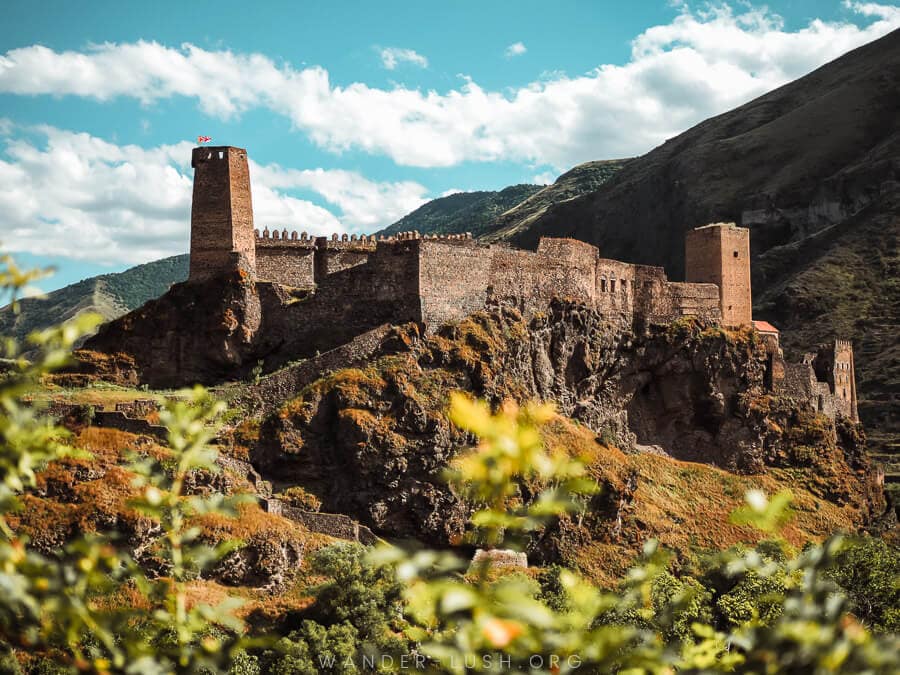
Where to stay in Akhaltsikhe
Located on the steep street that leads to the castle, Old Street offers a handful of large and very comfortably furnished rooms, one with an ensuite bathroom. The family live onsite and are very helpful with organising drivers, transport and the like. A fulsome breakfast can be added for a few extra GEL. We once had to wake up at dawn to catch a van when we stayed here and they very kindly prepared breakfast for us the night before so that we wouldn’t miss out.
How to get to Akhaltsikhe from Khulo
The mountain road between Khulo and Akhaltsikhe is still unpaved in sections and quite slow-going as a result. In 2024, work will continue and hopefully the entire road will be sealed and safe to drive soon.
A vehicle with high clearance, preferrably a 4WD, is required, and it’s not recommended to travel after heavy rain. If in doubt, call the Roads department hotline (+995 322 313 076) to check conditions.
There is only one daily direct marshrutka van during summer that I’m aware of – check times locally – or else you can travel by shared or private taxi. The trip takes around 3.5-4.5 hours via a beautifully scenic stretch of mountain road that passes by Goderdzi ski resort.
Note that the high pass is closed in winter. If you are travelling in the low season (approximately November to April), you will need to re-route back through Batumi and Khashuri instead.
How to visit Vardzia from Akhaltsikhe
Vardzia is 60 km south of Akhaltsikhe and can be reached in around 75 minutes by road. There are infrequent marshrutka vans to Vardzia from Akhaltsikhe’s bus station (see location here) for around 7 GEL one-way, but the more convenient way to travel is by hiring a car and driver to take you there and back. This should cost around 60 GEL including wait time, and your guesthouse in Akhaltsikhe will be able to organise it for you.
For times and fares, see this guide on how to get to Vardzia.
Day 17: Borjomi
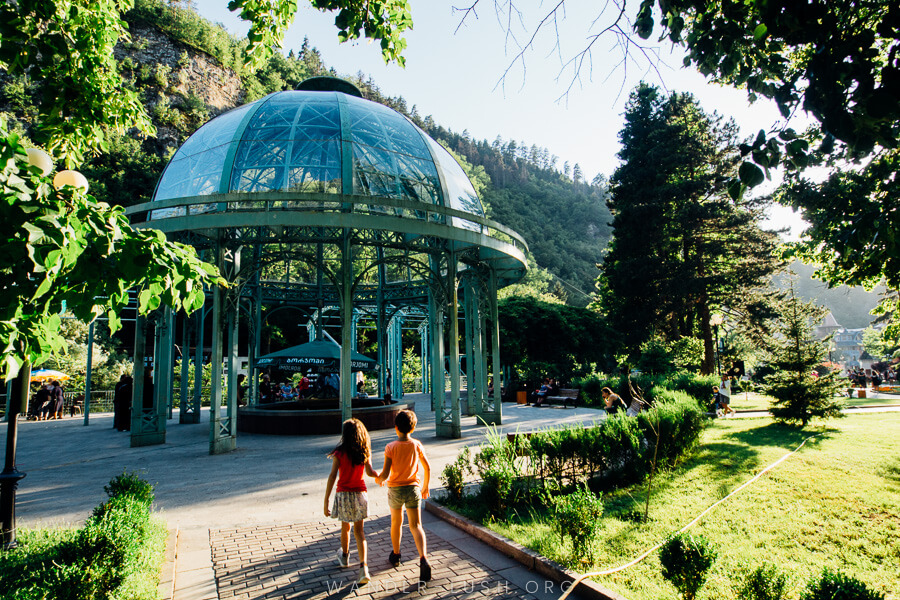
In Georgia and across the former USSR, Borjomi is associated with one thing: Mineral water. Natural carbonate springs were ‘discovered’ here in the 1850s, but archaeological evidence suggests the waters have been used for health purposes since at least the 7th century BC.
Today you can visit the original spring inside Borjomi Central Park – a leafy slice of parkland with walking trails, a cable car and open-air thermal baths – and fill up a bottle with water straight from the source.
Borjomi has traditionally been a place for rest and respite, so it’s a good place to pause for a day. Aside from the park and a short cable car, there are Soviet mosaics and Romanov-era buildings.
Unfortunately, Georgia’s only scenic railway, the Kukushka train from Borjomi to Bakuriani, was cancelled in 2020 and has not recommenced. Bakuriani village is a ski resort in wintertime and a lovely village in summer, with old sanatoriums and a Greek village in the hills nearby.
The stunning Romanov Palace in nearby Likani is also closed, with no re-opening date in sight. You can see objects from the palace on display at the Borjomi History Museum instead.
Outdoor enthusiasts can find easy day hikes and challenging multi-day expeditions in Borjomi Kharagauli National Park. Because of its lower elevation in the Lesser Caucasus, trails here open earlier than in Kazbegi or Svaneti – making it a great option for spring.
Recommended reading:
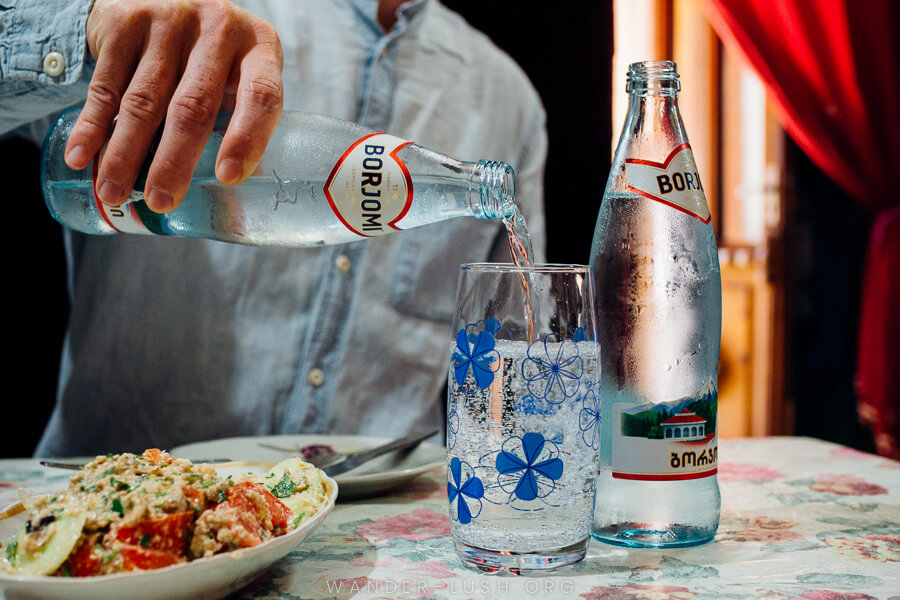
Where to stay in Borjomi
Self-contained apartment: Borjomi Cottages (formerly called Guest House on Erekle) is a terrific choice for singles or couples. They offer several self-contained studio apartments set inside little cabins, complete with a kitchenette and modern bathroom. It’s walking distance from the train station and Central Park, and Pesvebi restaurant – which happens to be run by the guest house owner’s sister – is just footsteps away.
Click here to check rates & availability on Booking.com.
Budget-friendly guesthouse: Guest House Besarioni is another solid choice in Borjomi. Private rooms are set inside a family home on the hill above town, accessed via a flight of stairs from the main street. Rooms are comfortable, there’s a washing machine, and the owner is extremely friendly and helpful. There are a number of short hiking trails in the hills above the guesthouse too.
Click here to check rates & availability on Booking.com.
Boutique hotel: Set in one of the most beautiful old buildings in Borjomi – a house built for the Iranian Consul – Golden Tulip Borjomi is steps from Central Park. Rooms are furnished in the same opulent style as the exterior. The upstairs breakfast terrace affords lovely views.
How to get to Borjomi from Akhaltsikhe
Borjomi is 50 km (around an hour by road) from Akhaltsikhe. There are minivan connections from the bus station in Akhaltsikhe throughout the day. The fare is around 5 GEL.
Optional detour: Abastumani instead of Borjomi
If you’re looking for an alternative to Borjomi, Abastumani is another former spa resort around 40 minutes north of Akhaltsikhe in the Lesser Caucasus. It too has hot springs, a Romanov Palace and heritage architecture, plus a Soviet-era mountain observatory where you take a tour of the restored telescopes or book in for an evening stargazing session.
See my Abastumani guide for more information, transport tips and accommodations.
Days 18 & 19: Sighnaghi & Kakheti wine region
Refer to days 4 & 5 of the one-week itinerary above.
Days 20 & 21: Georgian Military Highway & Kazbegi
Refer to days 6 & 7 of the one-week itinerary above.
One month in Georgia itinerary
If you’re able to budget four whole weeks for Georgia, you are setting yourself up for a really wonderful trip.
I call this the ‘Ultimate’ Georgia itinerary because it touches on all the major cities, historical and cultural sites and landscapes. It includes 21 cities and towns, 9 out of the 12 regions, and all 4 UNESCO Sites (plus 8 of the 15 Tentative Sites).
This itinerary follows the same format as previous routes but with more stops included. Additions are bolded:
Tbilisi – [David Gareja & Udabno] – Mtskheta, Gori & Uplistsikhe – Kutaisi, Chiatura & Tskaltubo – Martvili – Mestia & Ushguli – Zugdidi – Guria – Batumi – Khulo & Upper Adjara – Akhaltsikhe & Vardzia – Borjomi – Tsalka & Javakheti – Sighnaghi & Kakheti – Telavi – Pankisi Valley – Kazbegi – Tbilisi
- Days 1, 2 & 3: Tbilisi & day trips – overnight in Tbilisi
- Day 4: Day trip to David Gareja & Udabno – overnight in Tbilisi
- Day 5: Mtskheta, Gori & Uplistsikhe – overnight in Gori
- Days 6 & 7: Kutaisi, Chiatura & Tskaltubo – overnight in Kutaisi
- Day 8: Martvili – overnight in Martvili
- Days 9, 10 & 11: Mestia & Ushguli – overnight in Mestia
- Day 12: Zugdidi – overnight in Zugdidi
- Days 13 & 14: Guria – overnight in Ozurgeti
- Days 15, 16 & 17: Batumi & the Black Sea Coast – overnight in Batumi
- Days 18 & 19: Khulo & Upper Adjara – overnight in Khulo
- Day 20: Akhaltsikhe & Vardzia – overnight in Akhaltsikhe
- Day 21: Borjomi – overnight in Borjomi
- Day 22: Tsalka & Javakheti – overnight in Tbilisi
- Days 23 & 24: Sighnaghi & Kakheti wine region – overnight in Sighnaghi
- Day 25: Telavi – overnight in Telavi
- Days 26 & 27: Pankisi Valley – overnight in Jokolo
- Days 28, 29 & 30: Georgian Military Highway & Kazbegi – overnight in Kazbegi
Days 1, 2 & 3: Tbilisi
Refer to days 1, 2 & 3 of the three-week itinerary above.
Day 4: Day trip to David Gareja & Udabno
Refer to day 4 of the three-week itinerary above.
Day 5: Mtskheta, Gori & Uplistsikhe
Refer to day 4 of the two-week itinerary above.
Days 6 & 7: Kutaisi, Chiatura & Tskaltubo
Refer to days 5 & 6 of the two-week itinerary above.
Day 8: Martvili
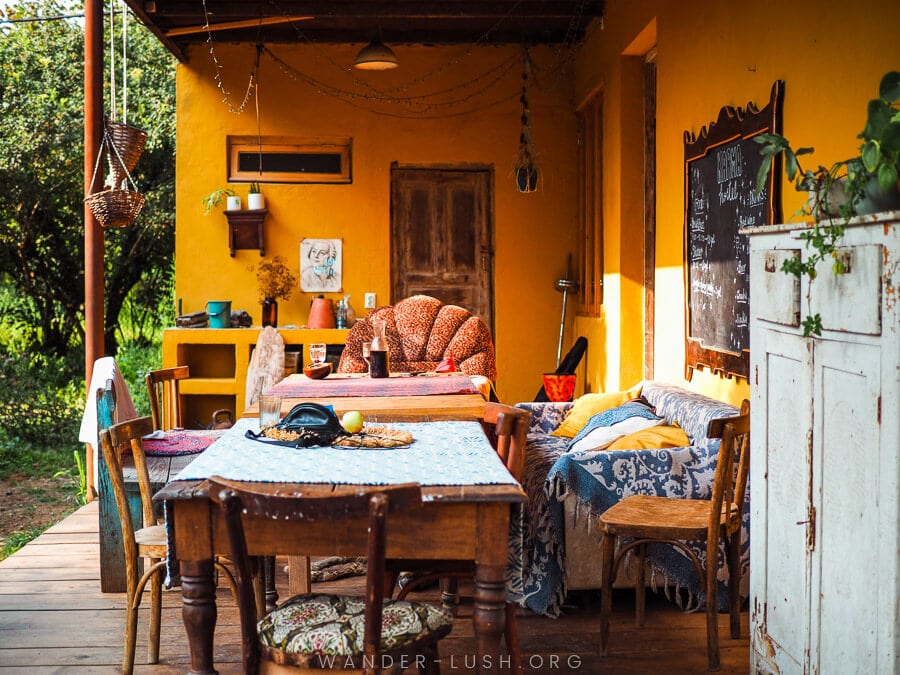
This one month Georgia itinerary is full to the brim, so I recommend enjoying a bit of downtime whenever you can.
Martvili, a small town in Samegrelo region, is the perfect place to pause between Kutaisi and Svaneti, giving you a chance for some much-needed rest between long drives. If you want to power through, you can easily travel directly from Kutaisi to Mestia and enjoy an extra day in the mountains.
There are a couple of noteworthy attractions in and around Martvili, including Martvili Monastery and two popular canyons, Martvili and Okatse. I’m not a huge fan of the canyons (or the nearby Kinchkha Waterfall) – all of these sites are overdeveloped in my opinion and charge a hefty entrance fee.
Personally I would suggest using your time in Martvili to relax at Karma Hostel, visit lesser-known canyons such as Balda and perhaps the hot springs at Nokalakevi, enjoy a meal at Oda Family Marani, and maybe visit the Martvili tea fields instead.
Don’t miss the monastery and if you happen to be in town on a Friday, be sure to attend the weekly farmers’ market.
How to get to Martvili from Kutaisi
There a dozen daily vans to Martvili from Kutaisi starting from around 8am and departing every hour until 6pm. The trip takes around an hour, and the fare is approximately 5 GEL. In Martvili, vans terminate in the centre of town. If you’re staying at Karma Hostel, you’ll want to jump off early at or near this gas station.
Days 9, 10 & 11: Mestia & Ushguli
Refer to days 7, 8 & 9 of the two-week itinerary above.
Day 12: Zugdidi
Refer to day 11 of the three-week itinerary above.
Days 13 & 14: Guria
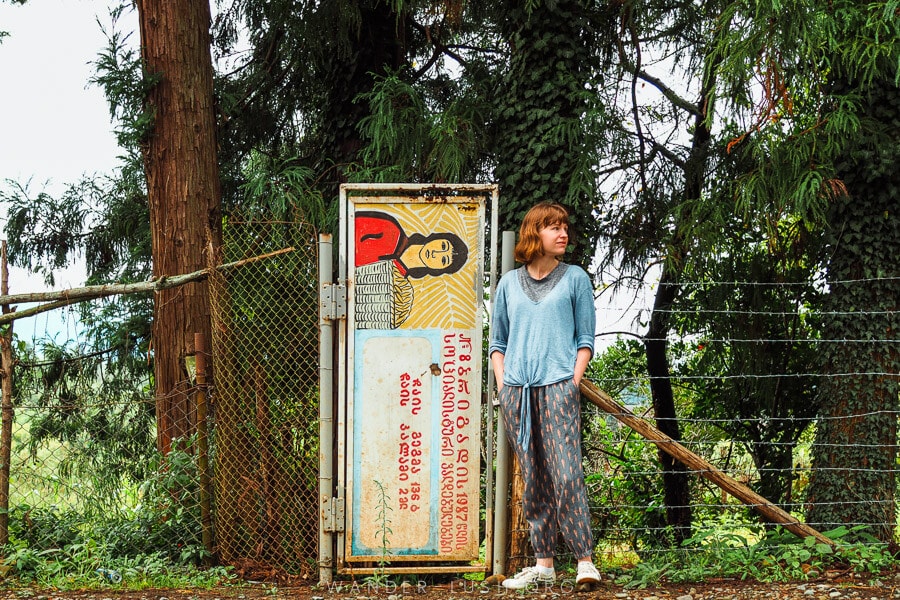
Western Georgia’s Guria Region is well and truly off the beaten track. I didn’t know anything about this part of Georgia before I visited this summer, but it quickly became one of my favourite places. I’ve been back several times since. The train station in Ozurgeti has passenger connections to Batumi and Tbilisi, making it relatively easy to get in and out.
As soon as you arrive in Guria, you will immediately notice the change in climate. This part of the country is very warm and humid, perfect conditions for growing hazelnuts and tea, the two crops this area is famous for.
Georgia’s little-documented tea heritage is absolutely fascinating and it all begins in Guria, where massive plantations and factories were built to furnish the entire Soviet Union with provisions for their daily cuppa.
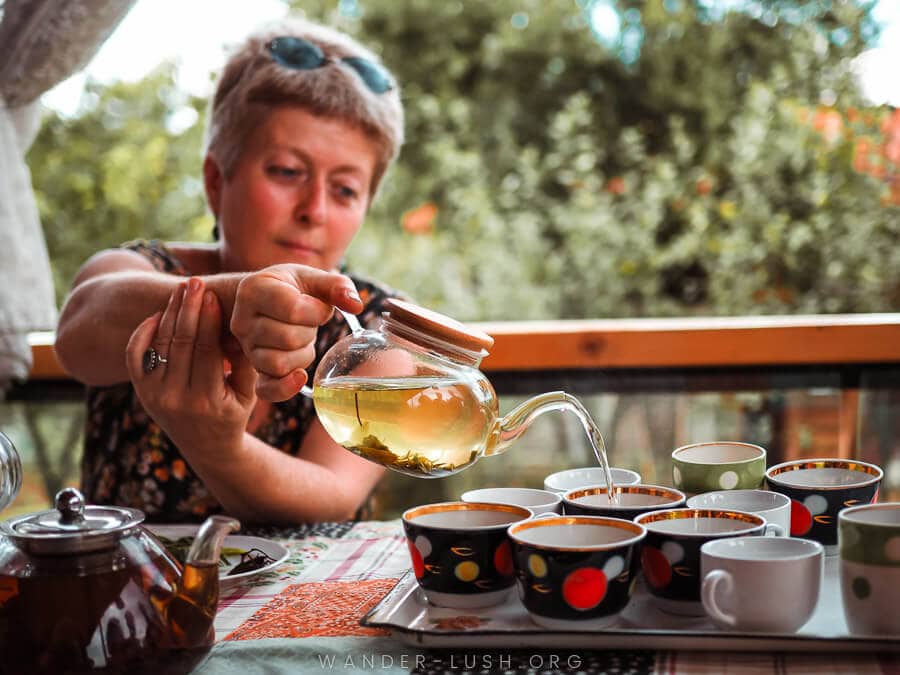
There isn’t a whole lot of infrastructure in Guria, so I recommend staying centrally in or near Ozurgeti, the region’s small capital. It’s worth coming this way just to spend a few nights at Komli, a family run guesthouse and tea farm 10 minutes from Ozurgeti.
To explore further afield – such as the tea fields in Anaseuli, the Soviet mosaics around Meria and the incredible Soviet architecture in the village of Shroma – you will need to organise a car and driver.
Don’t miss visiting either Gomismta or Bakhmaro, Guria’s twin mountain-top summer resorts that both offer stunning views (roads open in the warmer months only, unless you want to travel by snowmobile!).
Recommended reading:
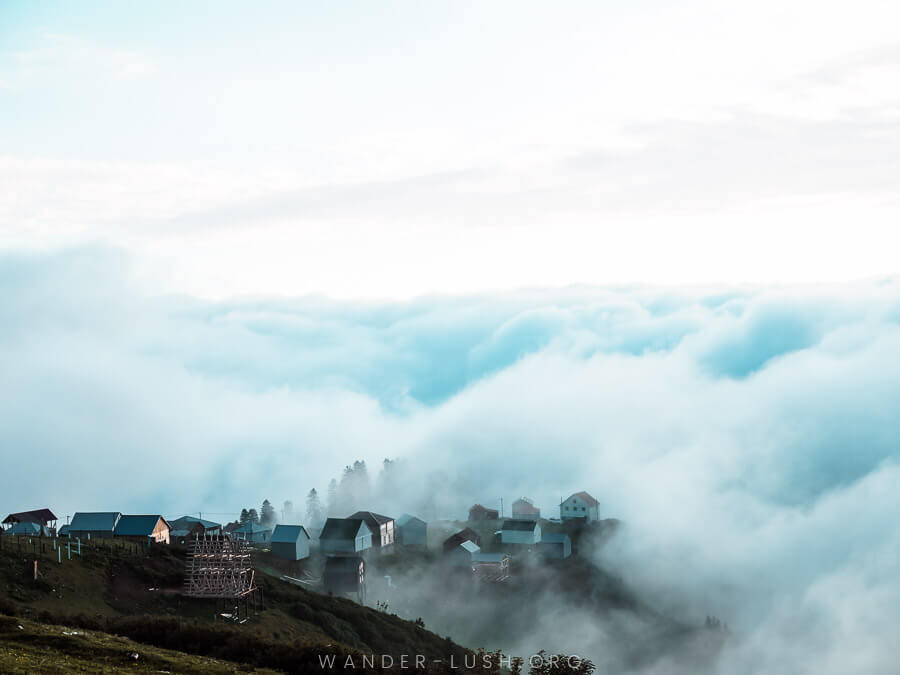
Where to stay in Guria
Guesthouse: Komli is one of the coolest accommodations in all of Georgia. Hosts Mariam, Lika and Mari – three generations of women – are personal friends of ours. There are just two guest rooms set inside their wooden home outside Ozurgeti, or you can sleep inside a giant wine barrel in the yard that’s been fitted out with a double bed.
The family has an intimate relationship with the tea industry and they keep a small field on the property where they harvest leaves. The only thing better than the tea is the home-cooked Gurian fare, served up in plentiful quantities on the outdoor deck.
Click here to check rates & availability on Booking.com.
Boutique guesthouse: Another solid option outside Ozurgeti in Shemokmedi, Menabde Winery is a historic wooden house that has been retrofitted into a comfortable guesthouse (all rooms have ensuite bathrooms) and a wine restaurant. This place is pure magic. Eating a home-cooked Gurian feast in the garden, accompanied by a bottle of house wine, is an unforgettable experience.
How to get to Guria from Zugdidi
Ozurgeti, Guria’s biggest city and main transport hub, is 100 km south of Zugdidi via Poti and the Black Sea Coast. Travel time by marshrutka is around 2.5 hours. Depending on the bus schedule, you might need to transit through Poti. Check times and fares at the bus station in Zugdidi.
Days 15, 16 & 17: Batumi & the Black Sea Coast

For things to do in Batumi, refer to days 9 & 10 of the two-week itinerary above.
This itinerary allows for an extra day on Black Sea Coast, which you can use to explore another of Adjara’s national parks. My personal favourite is the Machakhela Protected Areas, a magical landscape of primary forest along the Turkish border.
Or you could spend a day in Poti and visit the Colchic Wetlands, as described in the previous itinerary, or go mosaic hunting in Kobuleti, a small resort town near Batumi.
Recommended reading:
How to get to Batumi from Ozurgeti
To get from Ozurgeti to Batumi, I recommend taking a direct marshrutka van (2.5 hours) or a marshrutka via Ureki. Check times and fares locally.
Days 18 & 19: Khulo & Upper Adjara
Refer to days 14 & 15 of the three-week itinerary above.
Day 20: Akhaltsikhe & Vardzia
Refer to day 16 of the three-week itinerary above.
Day 21: Borjomi
Refer to day 17 of the three-week itinerary above.
Day 22: Tsalka & Javakheti
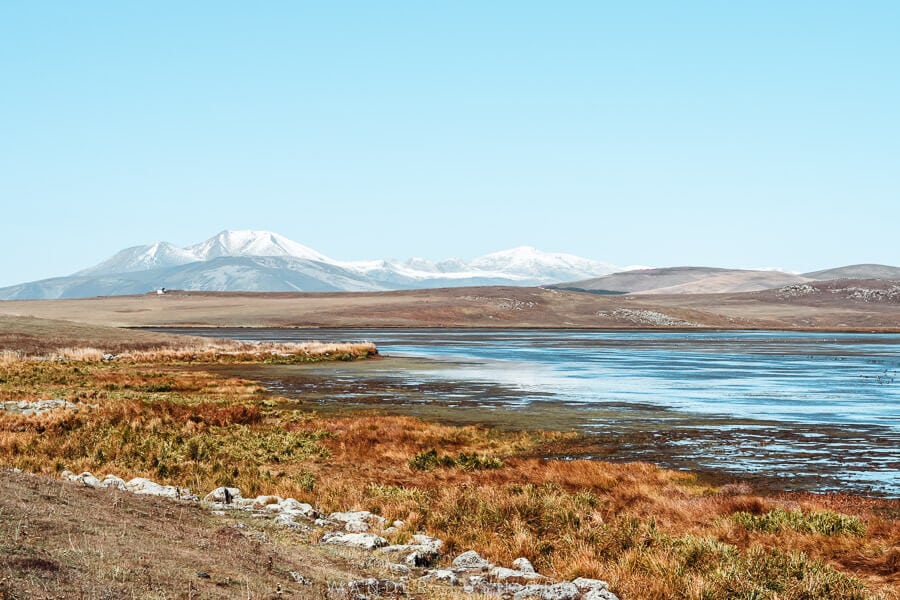
Another of Georgia’s lesser-visited areas, the Javakheti Protected Areas is a high-altitude plateau of volcanic lakes and endless plains. This is one of Georgia’s most majestic landscapes – a complete contrast to the lush west and mountainous north – and absolutely worth the detour if you have time.
You can see a lot in the space of a day if you hire a car and driver to take you through Javakheti on your way from Borjomi back to Tbilisi.
This area is known as the ‘Georgian Arctic’ because of the unforgiving climate. The landscape is covered with deep snow for much of the year, so make sure you have the right gear if you’re travelling in the colder months. In late summer and fall it becomes one of the region’s most important nesting grounds for endemic and migratory birds.
Each of the lakes has a bird watching tower and short hiking routes nearby. If you only have time for a couple of lakes, I suggest visiting Bughdasheni Managed Reserve and the nearby Doukhobor village of Gorelovka, plus Paravani Lake and Poka St. Nino Monastery (don’t miss the convent shop that sells delicious preserves and skincare products made from local beeswax and botanicals).
If there’s time, stop off in the city of Tsalka for lunch at Restaurant Pontia before visiting Dashbashi Canyon and the petroglyphs in Trialeti.
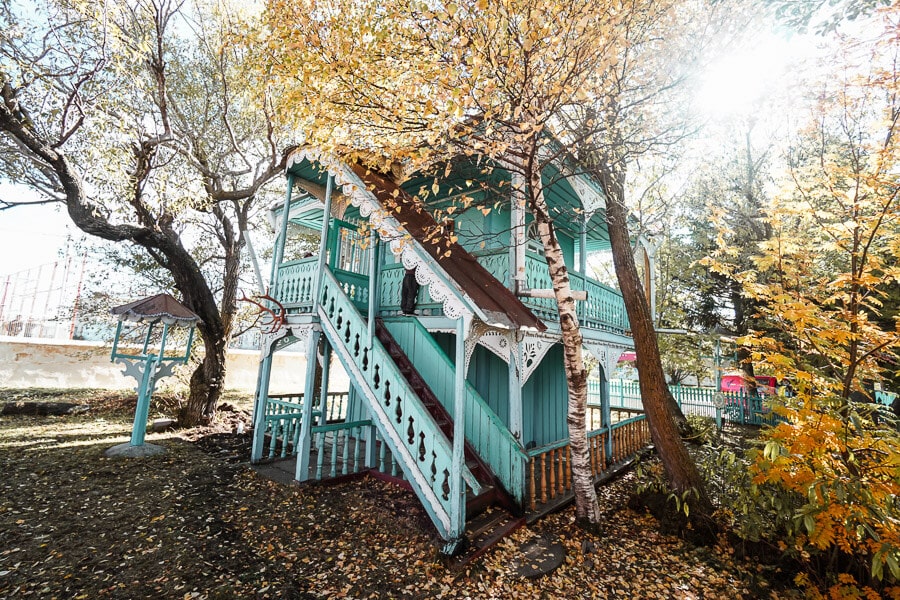
If you have time, drop by the historic German villages of Asureti and Trialeti in Kvemo Kartli region, and make a stop at Manglisi Cathedral the spectacular Didgori Battle Memorial before arriving back in Tbilisi.
If the lakes district doesn’t interest you, you can always head straight back to Tbilisi from Borjomi by marshrutka or train and spend an extra day in the capital instead.
Recommended reading:
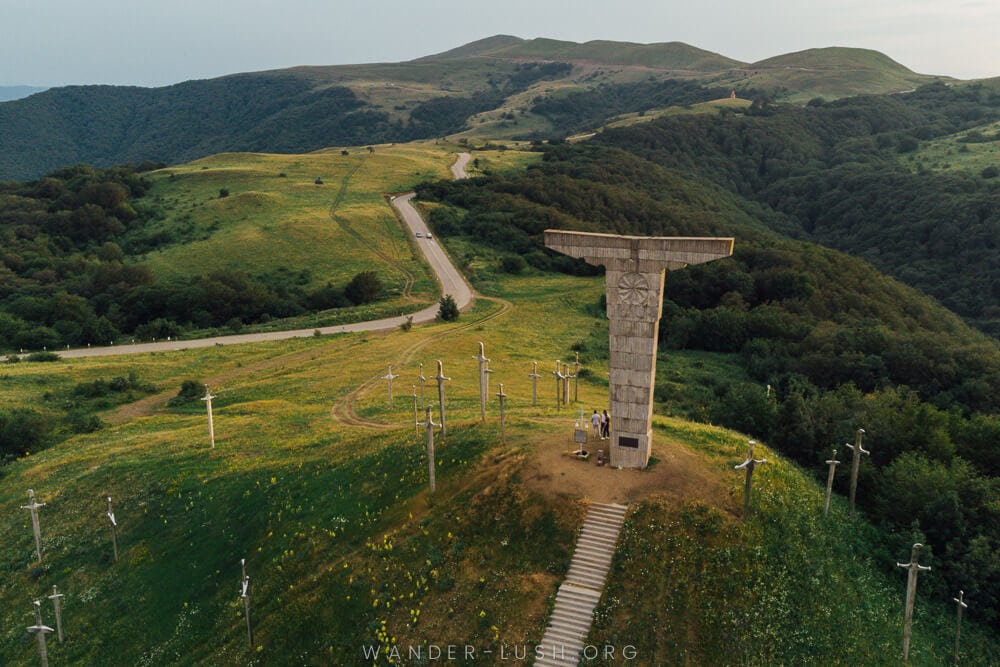
How to get to Tsalka & Javakheti from Borjomi
To travel between Borjomi and Tbilisi via Tsalka and Kvemo Kartli, you’ll need a car and driver. I recommend hiring a driver for the day through GoTrip for this route so that you can make as many stops along the way as you please.
Prices for Borjomi-Tsalka-Asureti-Didgori-Tbilisi start from 80 USD per car. Customise your itinerary and book a driver here.
Days 23 & 24: Sighnaghi & Kakheti wine region
Refer to days 4 & 5 of the one-week itinerary above.
Day 25: Telavi
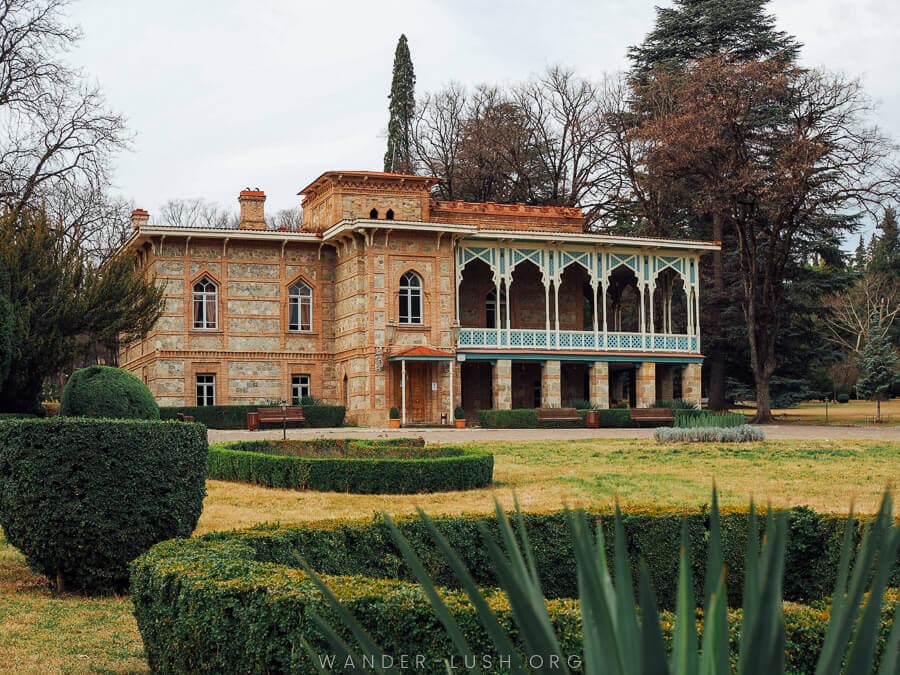
This extended Georgia itinerary allows for an extra day in the wine region. I recommend you spend it in Telavi, Kakheti’s biggest city.
You can find dozens more wineries in and around town for tours and tastings (Akido and Togonidze’s Wine Cellar are two of my favourites). If you skipped it on your first days, the historic Tsinandali Estate outside Telavi is a must-visit.
Telavi city itself is a very pleasant place to spend an afternoon. Wander beneath the balconies of the old town, visit the Giant Plane Tree – Telavi’s pride and joy – and explore the mammoth undercover market.
Where to stay in Telavi
Budget-friendly guesthouse: Guesthouse Lilia is a simple, warm and spotlessly clean family guesthouse in the centre of the city. The back garden and onsite wine cellar are a treat. Owner Lilia is very hospitable and can help with organising a car and driver to take you around for the day.
Click here to check rates & availability on Booking.com.
Mid-range hotel: Hestia Hotel, Wine and View offers the best of all three. Rooms are neat and stylish, and the panorama from the rooftop restaurant/bar is stunning.
Click here to check rates & availability on Booking.com.
Boutique hotel: Seventeen Rooms offers stylish modern rooms, an outdoor pool and delightful common areas, including a comfortable lounge with an open fireplace in winter. Some rooms have balconies overlooking the city. A generous breakfast is available, while lunch, dinner and local wines are served at the onsite restaurant.
Click here to check rates & availability on Booking.com.
Luxury hotel: The Radisson Tsinandali on the grounds of the Tsinandali Estate is a little bit pricey, but it’s worth every penny. Rooms are amazing, as is the buffet breakfast, and guests get unfettered access to the estate gardens. If you’re going to splurge on one hotel in Georgia, this is a great choice.
How to get to Telavi from Sighnaghi
There are only a handful of marshrutka services from Sighnaghi to Telavi – and the journey is quite slow as they stop frequently to pick up passengers from the villages along the highway.
It’s much more convenient to take a taxi between the two towns. This should take around 1.5 hours and cost somewhere in the neighbourhood of 60 GEL for a car. In Sighnaghi, taxis wait at the top of the park and down the road in front of the large building near the donkey statue.
If you’re already travelling the Wine Route, it might make more sense to throw your bags in the back of the car and ask your driver to drop you off in Telavi at the end of the day.
Days 26 & 27: Pankisi Valley
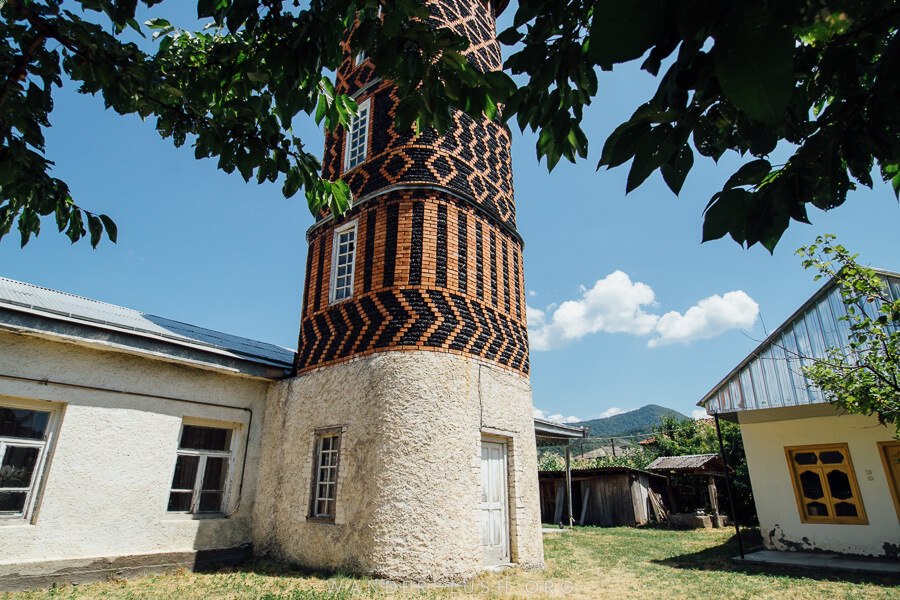
Visiting Pankisi Valley is one of the most memorable and enriching experiences you can have in Georgia.
Located in the north-eastern corner of Kakheti, the valley is defined by a series of small villages inhabited by families from the Kist community, whose ancestors migrated to Georgia from Chechnya 200 years ago. The area only opened to tourism relatively recently – it’s a real privilege and an honour to be able to observe the Kists’ rich and beautiful culture as a guest of the community.
Nazy’s Guest House in the village of Jokolo is the leading accommodation provider here. As well as offering comfortable rooms, Nazy can organise activities around the valley including guided cultural walks.
If you’re visiting on a Friday, you can attend the women’s zikr, a fascinating Sufi ritual that takes place every week. Eat copious amounts of delicious Kist food, and visit some of the many watchtowers, mosques and other historical monuments that dot the landscape.
Pankisi lies in the shadow of the Tusheti Protected Areas and is right on the doorstep of some immaculate nature. Marked hiking trails, guided mountain biking and horse trekking are all available.
Recommended reading:
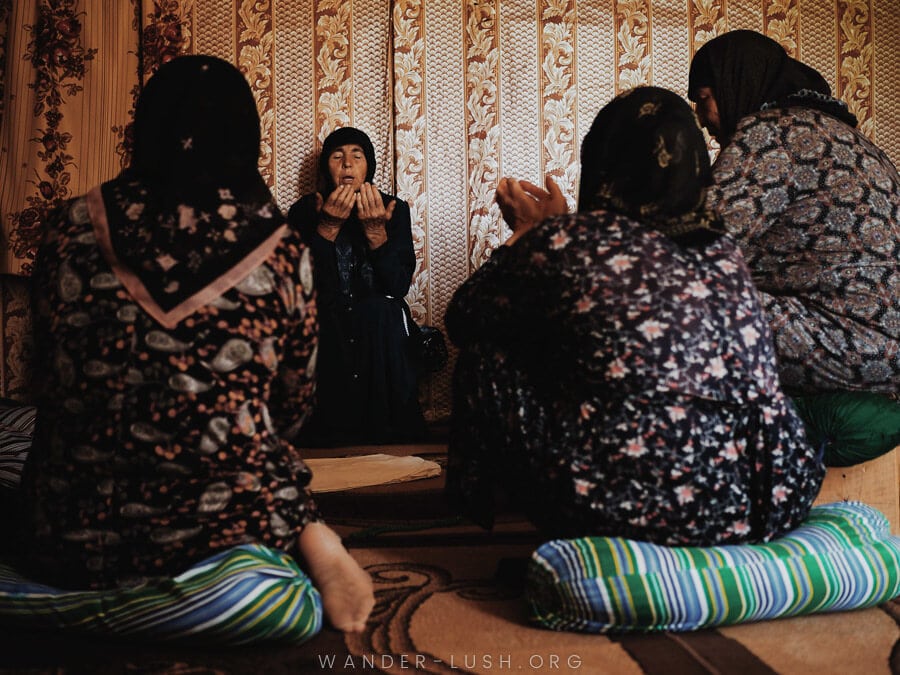
Where to stay in Pankisi
Nazy’s Guest House in Jokolo is the place to stay in Pankisi. Nazy has spearheaded tourism in the region and her family guesthouse is one of the longest-operating. Rooms are comfortably furnished, home-cooked meals are available, and Nazy can help organise everything from culinary classes to walking tours and guided horseback riding.
How to get to Pankisi from Telavi
Pankisi Valley is located less than an hour’s drive from Telavi. Marshrutka vans to Jokolo and Akhmeta, the nearest city to Pankisi, depart frequently from Telavi’s new bus station (see location here). The fare should cost around 7 GEL.
Alternatively, there are plenty of taxi drivers that know this route and will take you to Jokolo for around 30 GEL. They tend to wait near the bus station – ask around and no doubt you will find someone who knows Nazy.
Days 28, 29 & 30: Georgian Military Highway & Kazbegi
For things to do in Kazbegi, refer to days 6 & 7 of the one-week itinerary above.
This one month itinerary allows for an extra day in Kazbegi which you can either use for an additional day hike or for relaxing in town at Rooms.
For alternative hiking routes, Juta and Truso are both popular choices and easy to reach from Stepantsminda (see more in the next section below).
How to travel the Georgian Military Highway to Kazbegi from Pankisi
It’s possible to get onto the Georgian Military Highway from Pankisi without having to double-back through Tbilisi. Since I recommend using GoTrip for this route even if you are travelling from Tbilisi, you can simply organise for a driver to pick you up from Jokolo instead.
Organise for them to travel through Tianeti, a scenic (and newly sealed) backroad with a few places to stop along the way (including the delightful Kvetera Fortress’s Church).
From Tianeti, the road continues to the base of Zhinvali Reservoir and the start of the Georgian Military Highway, which you can then follow all the way up to Kazbegi with all the stops mentioned previously.
Total travel time from Jokolo to Kazbegi is just under 4 hours without stops. A car and driver for the day starts from 90 USD when booked through GoTrip.
More places to visit in Georgia
These itineraries hit on all the major highlights – but that’s really just the tip of the iceberg. If you have more time in Georgia (or you’re already planning your return trip), there are lots more places that are worthy of your time.
Here is a small handful. I’ve also included suggestions for where to slot these into your Georgia itinerary so as to avoid backtracking.
Tusheti – add 4-5 days
The Tusheti Protected Areas is located in far north-east Georgia along the border with Russia. It’s extremely remote – and extremely beautiful – but you need a good amount of time and an experienced driver to get there.
Tusheti is all about dramatic peaks and valleys, clusters of stone tower houses and massive herds of sheep, all shrouded in mist because of the high altitude. Remote villages such as Dartlo are only inhabited during summer and offer basic guesthouses, but infrastructure is overall pretty limited. This of course is part of the appeal. The main things to do in Tusheti are hike, horseback ride and enjoy the mountain hospitality.
The road up to Tusheti is only open in the warmer months, meaning you only have a small window to visit. The season changes year to year depending on the weather but it’s usually from early June until October.
You must go with an experienced local driver who knows the roads and has a good car. Shared and private cars can be arranged from Telavi, thus it makes the most sense to visit Tusheti after Kakheti wine region. See here for transport instructions. Adventurers can travel up by horseback from Pankisi Valley.
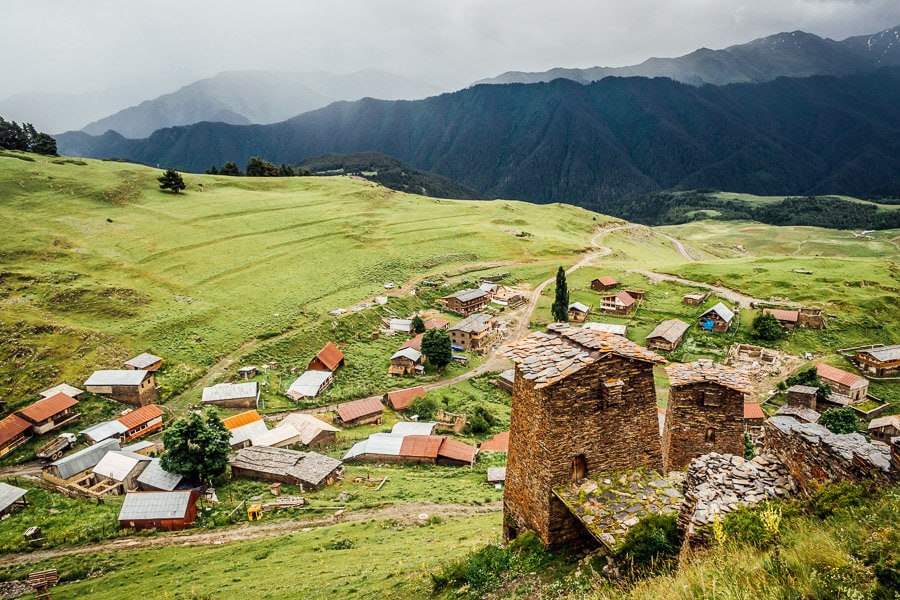
Khevsureti – add 3-4 days
Similar to Tusheti, Khevsureti is a remote region of the Greater Caucasus in Georgia’s north-east. It’s sandwiched between Kazbegi and Tusheti.
The main attraction here is the village of Shatili, home to yet more stone tower houses. It takes at least 5 hours to reach Shatili from Tbilisi by road via Roshka, so it’s recommended to spend at least 2 nights in a local guesthouse to make the most of it.
Khevsureti is on my list for 2024 – come back to this page for a full guide this summer!
Racha-Lechkhumi – add 2-3 days
Racha is a mountainous region in Western Georgia between Svaneti and South Ossetia. It’s very popular with locals but doesn’t attract many foreign visitors, mainly because it was always a bit trickier to get to without a car. That changed in 2021 when a new road opened from Sachkhere in Upper Imereti, making it possible to reach Oni in under 4 hours from Tbilisi.
Oni is a magical town with a stunning old synagogue. Shovi, an old Soviet summer retreat, is home to ‘Stalin’s Dacha’, and the more remote villages such as Ghebi offer hiking and homestays where you can eat ‘real’ Rachan cuisine and sip famous Khvanchkara wine pressed from grapes that only grow in Lower Racha.
It’s possible to get to Racha by marshrutka van from Kutaisi to Ambrolauri or Oni, as described in the ‘detour’ above. Adjacent Lechkhumi has magnificent rock karst formations and high-altitude villages. This is where you’ll find the Instagram-famous Lailashi Secret Pool.

Vashlovani Protected Areas – add 3-4 days
The far south-eastern corner of Kakheti region, approaching the border with Azerbaijan, is a wicked landscape of savannah plains and mud volcanoes. Vashlovani Nature Reserve is definitely an off-the-beaten track destination and only for the adventurous. You need your own 4WD to make the most of it.
While you’re in the area, be sure to spend a day around the town of Dedoplistskaro, visiting Eagle Gorge, Elia Monastery, and Big Shiraki, an abandoned Soviet airfield.
Lagodekhi National Park – add 2-3 days
Also in the eastern corner of Kakheti, Lagodekhi Nature Reserve is a lush forested landscape with plenty of hiking trails. One of the most popular routes is Black Rock Lake, a 2-day hike to the border with Azerbaijan and Russia. Duende Hotels offers delightful A-frame cabins on the edge of the park and is a great place to base your stay.
If you’re travelling to Azerbaijan next, you’ll pass right through Lagodekhi on your way to the border (keep in mind that overland travel into Azerbaijan is currently not possible as the country’s land border remains closed to inbound travellers until at least April 2, 2024.)
Otherwise you can easily get to the villages around the park from Tbilisi or Telavi by marshrutka.
Juta or Truso Valleys – add 1-2 days
If you’re looking for more hiking opportunities in the Greater Caucasus, Juta is an easy addition to your Georgia itinerary after Kazbegi. Fifth Season is a popular cabin accommodation in Juta and a good place to pair up with hiking buddies to tackle the trails around the valley.
Mountain Freaks organises transfers to Juta and Truso from Kazbegi throughout the trekking season.
Georgia essentials
Here are the websites and services I personally use and recommend for Georgia. Check out my full list of travel resources for more tips.
FLIGHTS: Search for affordable flights to Tbilisi, Batumi or Kutaisi on Skyscanner.
TRAVEL INSURANCE: Insure your trip with HeyMondo, my preferred provider for single-trip and annual travel insurance (get 5% off when you book with my link).
SIM CARD: Magti is my preferred provider, with prices starting from 9 GEL/week for unlimited data. See this guide for all the details about buying a Georgian SIM card.
AIRPORT TRANSFERS: Most flights into Georgia arrive in the early hours. For ease, pre-book a private transfer from Tbilisi Airport to your hotel (from $17) or from Kutaisi Airport to Tbilisi (from $90) with my partners at GoTrip.ge.
ACCOMMODATION: Booking.com is the most widely used platform in Georgia. Use it to find family guesthouses, private apartments, hostels and hotels around the country.
CAR HIRE: Find a great deal on a rental car in Georgia – use the Local Rent website to book through a local agent (prices start from $20/day).
DAY TRIPS & CITY TOURS: Use Viator or Get Your Guide to browse a range of day trips and city tours. For off-beat programs, I recommend Friendly.ge (use the promocode wanderlush for 10% off). For in-depth day trips to Georgia’s wine regions, I recommend Eat This! Tours (use the promo code wanderlush for 5% off).
PRIVATE TRANSFERS: GoTrip.ge is a terrific service for booking a private professional driver and car for the day. Use it for A-to-B transfers, a customised round-trip itinerary, or a multi-day trip. You can stop wherever you like for as long as you like without the fixed price going up.
NEED SOME HELP?: Need feedback on your itinerary or personalised travel tips? I offer a one-on-one consultation call service for Tbilisi and Georgia. More information and bookings here.
